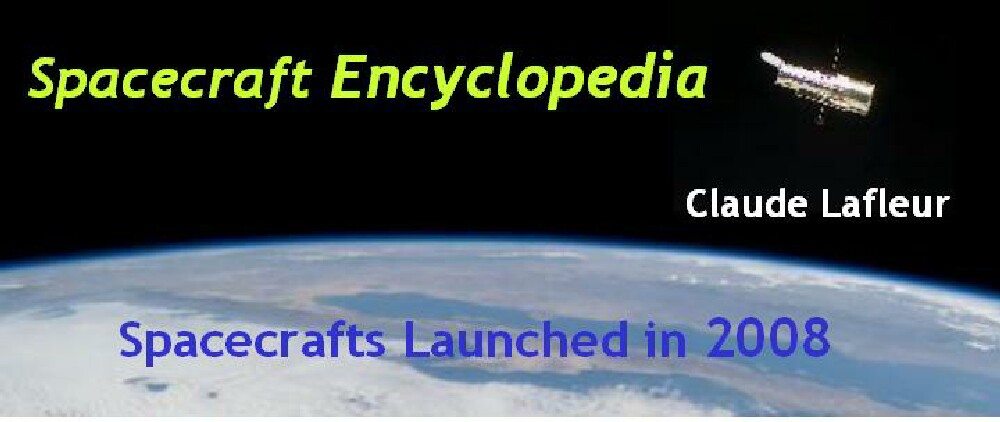The
111 Spacecrafts Launched in 2008 :
.
.
Thuraya 3
| Spacecraft: |
|
| Chronologies: |
2008 payload # ; 2008-001A ; 6,615th spacecraft. |
| Type: |
Communications (Phone) |
| Families: |
1,051th Civilian
Communications satellite ; 809th Geostationary
satellite. |
| Ranks: |
2,9287h Civilian
spacecraft (16th Arabian); 16th
Arabian satellite
(16th Civilian). |
| Sponsor: |
Thuraya Satellite Telecommunications Company
(United Arab Emirate) |
|
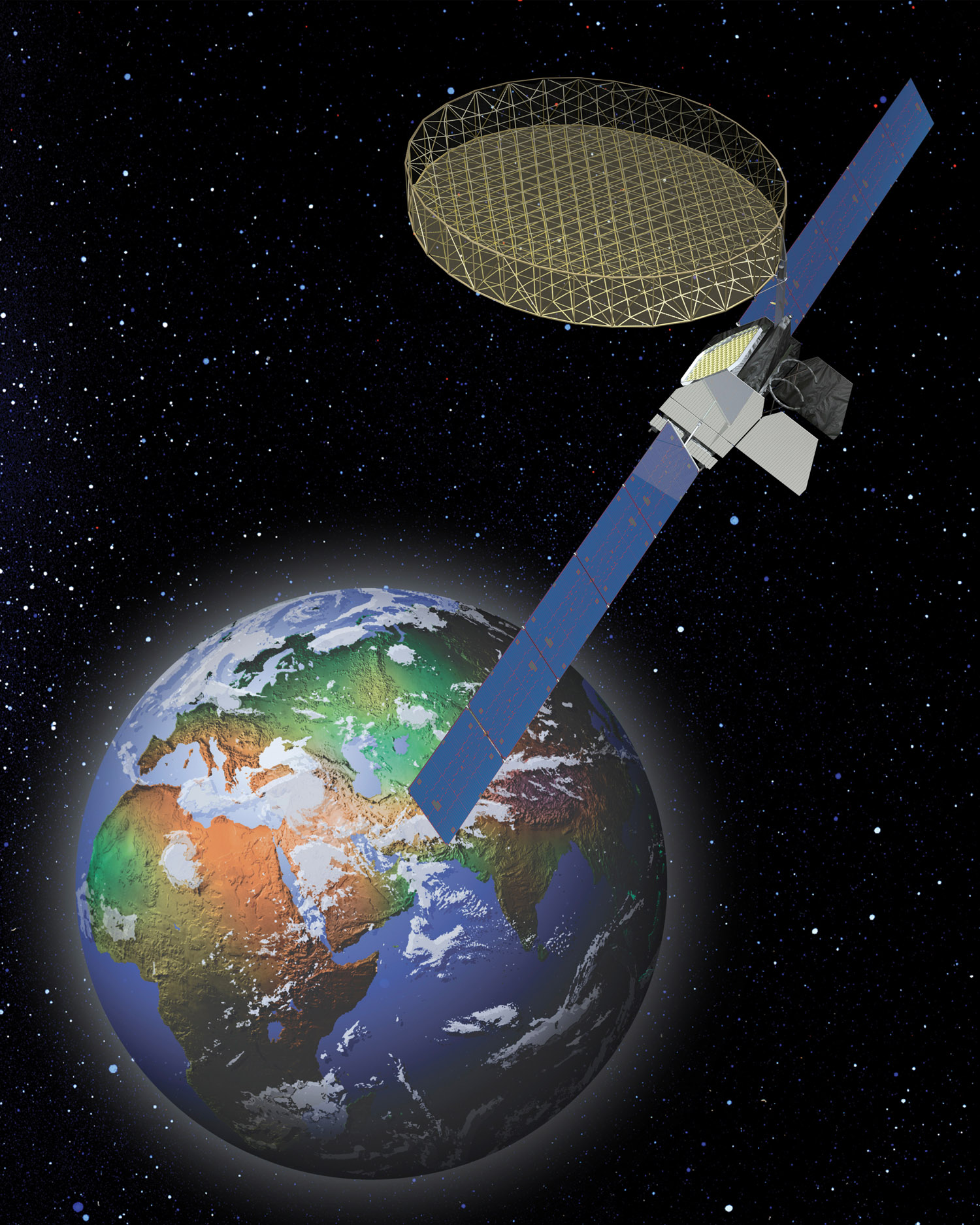
Source: Boeing
|
| Launch: |
14 January 2008 at 11h49 UTC,
from Odyssey Launch Platform, by a Zenit-3SL.
(The Odyssey plastorm was positioned in the
Pacific Ocean along the equator at 154° West longitude.) |
| Orbit: |
Geostationary at 98.5° East longitude. |
| Mission: |
Thuraya 3 is a 5250-kg mobile communications
system serves a region of 2.3 billion people.
Boeing Satellite
Systems (BSS) built the complete turnkey system under a contract signed
on Sept. 11, 1997. This included the manufacture and October 2000 launch
of Thuraya-1, a high-power Boeing GEM satellite, plus a second spacecraft,
ground facilities and user handsets. The system began commercial operations
in mid-2001. Sea Launch successfully orbited Thuraya-2 on June 10, 2003.
The Thuraya company has exercised an option to order Thuraya-3 as a ground
spare. The Thuraya satellites are the first spacecraft in the Boeing GEO-Mobile
satellites (GEM) series which integrate a high-power geosynchronous satellite
(derived from the Boeing 702 body-stabilized design) with a ground segment
and user handsets, to provide a range of cellular-like voice and data services
over a large geographic region. . Sea Launch successfully launched Thuraya-1,
in October 2000 and Thuraya-2 in June 2003. |
| Source: |
Jonathan
Space Report No. 590
; Spacewarn No. 651
; National Space Science Data Center's
2007-0 ; SkyRocket's Thuraya
3 ; Boeing's Thuraya
2/3 ; Sea Launch's ;
Thuraya's
: Spaceflgiht Now's 14
Jan 08 ; |
|
The Zenit 3SL rocket launched Thuraya
3 satellite (Photos: Sea
Launch)
|
.
Polaris / TECSAR 1
| Spacecraft: |
|
| Chronologies: |
2008 payload #2 ; 2008-002A ; 6,616th spacecraft. |
| Type: |
Radar Surveillance |
| Families: |
1200th Radar
Surveillance satellite. |
| Ranks: |
3,689th Military
spacecraft (8th Israelian) ; 11th Israelian
satellite (8th Military). |
| Sponsor: |
Israel Defense Ministry |
|
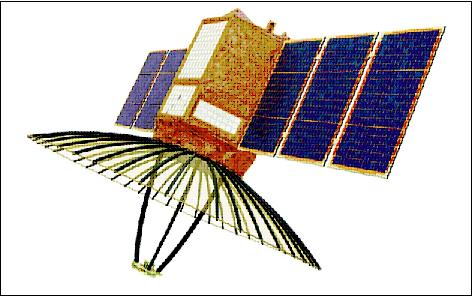 |
The PSLV C10 rocket launched TechSAR
satellites (Photos:
ISRO)
|
.
Express-AM33
| Spacecraft: |
|
| Chronologies: |
2008 payload #3 ; 2008-003A ; 6,617th spacecraft. |
| Type: |
Communications |
| Families: |
1,052nd Civilian
Communications satellite ; 810th Geostationary
satellite. |
| Ranks: |
2,928th Civilian
spacecraft (1,053 Russian) ; 3,494th
Russian
spacecraft (1053rd Civilian). |
| Sponsor: |
Russian Satellite Communications Company
(RSCC) |
|
|
| Launch: |
28 January 2008 at 0h18 UTC,
from Baykonur Cosmodrome's LC-200, by a Proton
M/Breeze M. |
| Orbit: |
Geostarionary at 96.5° East longitude |
| Mission: |
Express-AM33 is a 2,579-kg (dry) communications
satellites that carries 10 C-band, 16 Ku-band and 1 L-band transponders
to provide digital TV services, Internet access, data transmission, video
conferencing as well as mobile presidential and governmental communications.
It also provide VSAT services across Russia, CIS countries, Europe, Asia
and Africa. Ordered by Russian Satellites Communications Company, the satellite
was manufactured by NPO PM (Krasnoyarsk) together with Thales Alenia Space
(France). Express-AM33 is the sixth implementation of the Express-AM satellite
platform. The distinctive feature of the new satellite is the steerable
C- and Ku-band antennas enabling a most flexible respond to different customer
requests. Its orbital operational life is 12 years |
| Source: |
Jonathan
Space Report No. 591
; Spacewarn No. 651
; National Space Science Data Center's
2007-0 ; SkyRocket's ; SpaceflightNow's
28
Jan 08 ; RSCC's 28
Jan 08 ; TASS' 4
Feb 15, 4 Feb
15 ; |
|
|
.
Progress M-63 / ISS
28P
| Spacecraft: |
Progress M (7K-TGM) No. 363 |
| Chronologies: |
2008 payload #4 ; 2008-004A ; 6,618th spacecraft. |
| Type: |
Cargo delivery to the International Space
Station |
| Families: |
476th Piloted
Spaceship (289th Russian) ; 118th Progress
cargoship ;
69th ISS
Operation (46th Russian). |
| Ranks: |
2,929th Civilian
spacecraft (1,054 Russian) ; 3,495th
Russian
spacecraft (1054th Civilian). |
| Sponsor: |
Russian Federal Space Agency |
|
 |
Progress M-63 in preparation. (Photos:
RSC
Eneregia)
Progress M-63 arrival at ISS, on 7 February
2008 (Photos: NASA)
| Launch: |
5 February 2008 at 13h03 UTC,
from Baykonur Cosmodrome's LC-1, by a Soyuz
U. |
| Orbit: |
Initial: 191.2 km x 263.6 km x 51.63°
x 88.77 min.
332.0 km x 354.8 km x 51,6° x 91.1 min. |
| Deorbit: |
7 April 2008 over the Pacific Ocean. |
| Mission: |
Progress M-63 is a cargo transport craft
that deliver to the International Space Sration more than 2.5 tons of various
cargoes that are needed to support the operation of ISS, This cargo
comprize supplies of oxygen, water and food, propellants, consumables,
scientific instrumentation and equipment. Intended for the US segment are
395 kg of cargo Progress M-63 is the 28th Russian logistics spacecraft
(ISS-28P) launched toward ISS. Proximity operations, fly-around maneuver
and docking were performed in automatic mode. Initial contact with the
docking port of the Pirs docking module/compartment occurred at 1438 UTC.
Progress M-63 successfully
undocked from the ISS on 7 April 2008 at 4h49 EDT. All separation
burns went off nominally, and the deorbit burn followed at 7h50 for destructive
reentry over the Pacific Ocean. (For the first time in many years, there
is no Progress docked at ISS. The next Progress arrival is schedule for
mid-May.) |
| Source: |
Jonathan
Space Report No. 591
; Spacewarn No. 652
; National Space Science Data Center's
2007-0 ; SkyRocket's ; RSC
Energia's 5
Feb 08 & 7
Fév 08 ; |
|
Launch of Progress M-63 by a Soyuz U.
(Photos: RSC
Energia)
|
.
STS-122 / ISS 1E
| Spacecraft: |
Space Shuttle's 121st flight,
Atlantis' 29th flight and 24th Shuttle flight to ISS. |
| Chronologies: |
2008 payload #5 ; 2008-005A ; 6,619th spacecraft. |
| Type: |
Piloted Spaceship |
| Families: |
266th Human
Spaceflight (153rd American) ; 477th Piloted
Spaceship (182nd American) ; 70th ISS
Operation (24th American). |
| Ranks: |
2,930th Civilian
spacecraft (1769th American) ; 1,769th
American
spacecraft (626th Civilian). |
| Sponsor: |
NASA |
|
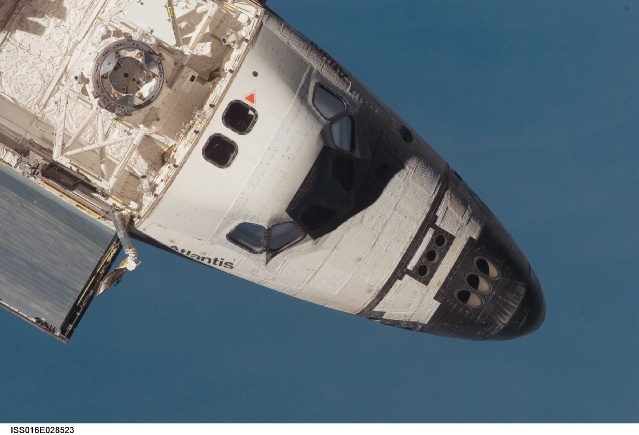
Source: NASA
|
| Launch: |
7 February 2008 at 19h45 UTC,
from Kennedy Space Center's LC-39A, by the Space
Shuttle |
| Orbit: |
|
| Mission: |
STS-122 is a piloted mission which carry
a crew of seven astronauts to deliver the Columbus science laboratory,
Europe’s primary contribution to ISS, to the International Space Station.
Aboard Atlantis are Commander Steve Frick, Pilot Alan Poindexter and Mission
Specialists Leland Melvin, Rex Walheim, Stanley Love, Hans Schlegel and
Leopold Eyharts. Following Atlantis arrival at ISS, Eyharts becomes a member
of the Expedition 16 crew, joining Commander Peggy Whitson and Flight Engineer
Yuri Malenchenko, as Dan Tani, who has been aboard the station since October
2007, return to Earth on Atlantis.
Following a flawless
rendezvous, Atlantis docked onto the PMA-2 on 9 February à 12h15
EST. Hatchs opening was at 13h40. NASA then announced that it will
delayed the first spacewalk and installation of Columbus on ISS by one
day, because of a ˜crew medical issue˜ affecting Schlegel. Schlegel, who
was scheduled to make the first EVA with Walheim, will be replace Love. |
| Source: |
Jonathan
Space Report No. 591
; Spacewarn No. 652
; National Space Science Data Center's
2007-0 ; SkyRocket's ; NASA's
STS-122
& STS-122
Press Kit ; |
|
|
.
The International Space Station at the
end of the STS-122 mission (S122-E-009856,
S122-E-009880
& S122-E-011112)
.
Columbus Science Laboratory
| Spacecraft: |
|
| Chronologies: |
2008 payload #6 ; 2008 n/a ; 6,620th spacecraft. |
| Type: |
Science Laboratory / Space Station Component |
| Families: |
478th Piloted
Spaceship (1st European). |
| Ranks: |
2,931st Civilian
spacecraft (255th European) ; 291st
European
spacecraft (255th Civilian). |
| Sponsor: |
ESA |
|
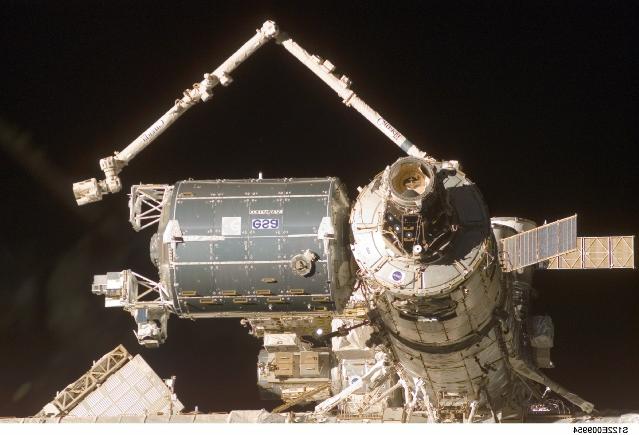
Source: NASA
|
Artist concepts of ISS with the Columbus
Laboratory (Sources: NASA
& ESA)
| Launch: |
7 February 2007 at 19h45 UTC,
from Kennedy Space Center's LC-39A, by the Space
Shuttle
Columbus was officially attached to ISS on
11 February 2008 at 16h44 EST. |
| Orbit: |
Part of the International Space Station. |
| Mission: |
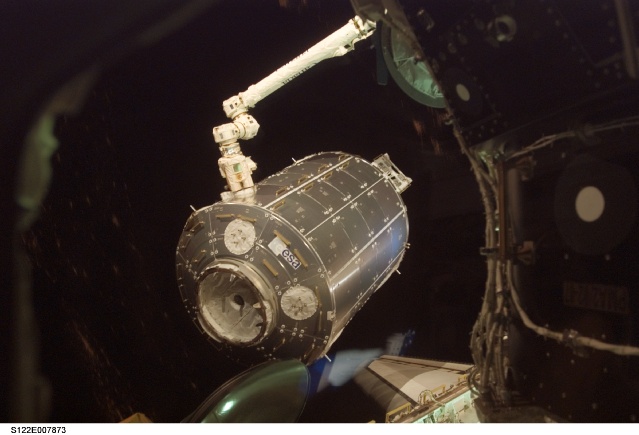 Columbus
is a 12,775-kg research laboratory which is permanantly attached to the
International Space Station to provides internal payload accommodation
for experiments in the field of multidisciplinary research into material
science, fluid physics and life science. In addition, an external payload
facility hosts experiments and applications in the field of space science,
Earth observation and technology. Attached to ISS Node 2 Harmony
starboard docking port, Columbus is equipped with flexible reseach facilities
that offer extensive science capabilities. It is ESA's biggest single contribution
to the International Space Station. Columbus
is a 12,775-kg research laboratory which is permanantly attached to the
International Space Station to provides internal payload accommodation
for experiments in the field of multidisciplinary research into material
science, fluid physics and life science. In addition, an external payload
facility hosts experiments and applications in the field of space science,
Earth observation and technology. Attached to ISS Node 2 Harmony
starboard docking port, Columbus is equipped with flexible reseach facilities
that offer extensive science capabilities. It is ESA's biggest single contribution
to the International Space Station.
During its 10-year
projected lifespan, the 4.5-metre diameter, with 75 cubic metres of space
inside, cylindrical laboratory will be able to conduct thousands
of experiments all in the weightlessness of orbit. The Columbus laboratory
has room for ten International Standard Payload Racks (ISPRs), eight situated
in the sidewalls, and two in the ceiling area. Each rack is the size of
a telephone booth and able to host its own autonomous and independent laboratory,
complete with power and cooling systems and video and data links back to
researchers on Earth. Outside its comfortable, pressurized hull,
Columbus has four mounting points for external payloads. Exposed to the
vacuum of space, and with an unhindered view of the Earth and outer space,
science packages can investigate anything from the ability of bacteria
to survive on an artificial meteorite to volcanic activity 400 km below
on the Earth.
Columbus dimensions:
total module length: 6,87 metre, largest diameter: 4.48 metre, and total
internal volume: 75 cubic-meter. Columbus launch mass was 12,775 kg (with
2,500 kg of payload), its mass without payload being 10,275 kg. Maximum
on orbit mass is 21,000 kg (with a maximum payload mass of 9,000 kg). |
| Source: |
Jonathan
Space Report No. 591
; Spacewarn No.
; National Space Science Data Center's
2007-0 ; SkyRocket's ; ESA's
Columbus
& Overview
; STS-122
Press Kit |
|
|
.
Thor 5 (Thor 2R)
| Spacecraft: |
|
| Chronologies: |
2008 payload #7 ; 2008-06A ; 6,621st
spacecraft. |
| Type: |
Communications |
| Families: |
1,053rd Civilian
Communications satellite ; 811th Geostationary
satellite. |
| Ranks: |
2,932nd Civilian
spacecraft (540th Commercial) ; 540th Commercial
spacecraft (540th Civilian). |
| Sponsor: |
Norway's Telenor Satellite Broadcasting |
|
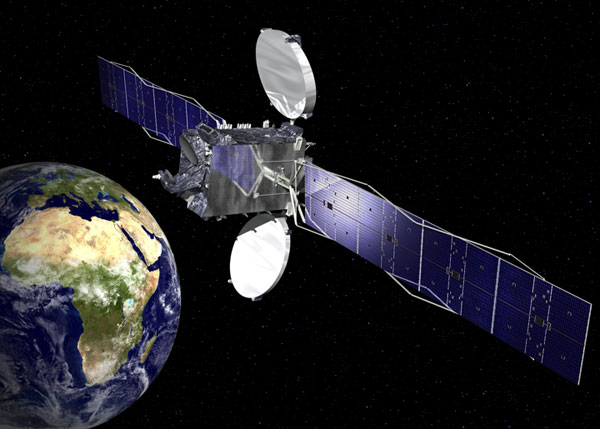
Source: OSC
|
|
.
WINDS / Kizuna
| Spacecraft: |
Wideband Inter-Networking engineering
test and Demonstration Satellite |
| Chronologies: |
2008 payload #8 ; 2008-07A ; 6,622nd spacecraft. |
| Type: |
Communications |
| Families: |
1,054dh Civilian
Communications satellite ; 812th Geostationary
satellite. |
| Ranks: |
2,933rd Civilian
spacecraft (111th Japanese) ; 118th
Japanese
spacecraft (111th civilian). |
| Sponsor: |
Japan Aerospace Exploration Agency (JAXA) |
|

Source: JAXA
|
|
.
ATV-1 Jules Verne
| Spacecraft: |
ATV stands for Automated Transfer
Vehicle |
| Chronologies: |
2008 payload #9 ; 2008-08A ; 6,623rd spacecraft. |
| Type: |
Cargo delivery to the International Space
Station (1st European cargo) |
| Families: |
479th Piloted
Spaceship (2nd European) ;1st European
cargoship ; 71st
ISS Operation (1st
European). |
| Ranks: |
2,934th Civilian
spacecraft (256th European) ; 292nd
European
spacecraft (256th Civilian). |
| Sponsor: |
European Space Agency |
|

Source: ESA
|
Source:
NASA.
| Launch: |
9 March 2008 at 4h03 UTC, from
Kourou Space Center's ELA-3, by an Ariane
5 ES. |
| Orbit: |
At ISS docking (3 Apr 08) : 338.4 km x 339.7
km x 51.64° x 91.32 min. |
| Mission: |
 ATV-1,
nicknamed Jules Verne, is the first European cargo transport ship that
delivers 8 tons of supplies to the Internation Space Station. It had a
total mass of 20,750 kg at liftoff and carries 5,752 kg of maneuver propellant,
860 kg ISS refuel propellant, 20 kg oxygen gas, 280 kg water and 1,150
kg varied dry cargo. After a four-week orbital test flight, the craft
docked successfully at the Service Module aft port on 3 April 2008 at 10h45
EDT. The cargo transport, which remains docked for the next four
months, is delivering 1,150 kg of dry cargo, including food, clothes and
equipment as well as two original manuscripts handwritten by Jules Verne
and a 19th Century illustrated edition of his novel “From the Earth to
the Moon”. The cargo also includes 856 kg of propellant, 270 kg of
drinking water and 21 kg of oxygen, to be transferred to the Station. ATV-1,
nicknamed Jules Verne, is the first European cargo transport ship that
delivers 8 tons of supplies to the Internation Space Station. It had a
total mass of 20,750 kg at liftoff and carries 5,752 kg of maneuver propellant,
860 kg ISS refuel propellant, 20 kg oxygen gas, 280 kg water and 1,150
kg varied dry cargo. After a four-week orbital test flight, the craft
docked successfully at the Service Module aft port on 3 April 2008 at 10h45
EDT. The cargo transport, which remains docked for the next four
months, is delivering 1,150 kg of dry cargo, including food, clothes and
equipment as well as two original manuscripts handwritten by Jules Verne
and a 19th Century illustrated edition of his novel “From the Earth to
the Moon”. The cargo also includes 856 kg of propellant, 270 kg of
drinking water and 21 kg of oxygen, to be transferred to the Station. |
| Source: |
Jonathan
Space Report No. 592
; Spacewarn No. 653
; National Space Science Data Center's
2007-0 ; SkyRocket's ; Arianespace's
9
Mar 08 ; ESA's 9
Mar 08 ; SpaceflightNow's
9
Mar 08 ; |
|
|
.
STS-123 / ISS J/A
| Spacecraft: |
Space Shuttle's 122nd flight,
Endeavour's 21st flightand 25th Shuttle flight to ISS. |
| Chronologies: |
2008 payload #10 ; 2008-09A ; 6,624th spacecraft. |
| Type: |
Piloted Spaceship |
| Families: |
267th Human
Spaceflight (154th American) ; 480th Piloted
Spaceship (183rd American) ; 72nd ISS
Operation (25th American). |
| Ranks: |
2,935th Civilian
spacecraft (1770th American) ; 1,770th
American
spacecraft (627th civilian). |
| Sponsor: |
NASA |
|

Source: NASA
|
| Launch: |
11 March 2008 at 6h28 UTC, from
Kennedy Space Center's LC-39A, by the Space
Shuttle. |
| Orbit: |
At ISS docking: 340.4 km x 342.0 km x 51.64°x
91.36 min. |
| Lander: |
26 March 2008 at 20h39 EDT, at the Kennedy
Space Center. |
| Mission: |
STS-123 / ISS-1J/A is carrying the 8,387-kg
Japanese Experiment Logistics Module-Pressurized Section (ELM-PS or JLP)
and the 1,542-kg Canadian Special Purpose Dexterous Manipulator (SPDM)
“Dextre”. Onboard Endeavour is a seven-member crew of Commander Dominic
Gorie, Pilot Gregory Johnson and Mission Specialists Richard Linnehan,
Robert Behnken, Michael Foreman, Takao Doi and Garrett Reisman. Reisman
replaces Léopold Eyharts as ISS Expedition 16 Flight Engineer 2.
Endeavour docked
to the PMA-2 of ISS on 12 March at 23h49 EDT. The crew perform five EVA
to install the JLP and Dextre. EVA-1 was completed on 14 March by Linnehan
and Reisman in 7 hr. and 1 min. Japan’s JLP module was successfully
installed on the Node-2 “Harmony” on 14 March at ~3:00 EDT. (It added approximately
55 cubic-metres of internal volume to ISS.) EVA-2 was completed on 16 March
by Linnehan and Foreman in 7 hr. and 8 min. EVA-3 was completed on 18 March
by Linnehan and Behnken in 6 hr. and 53 min. On 19 March, Dextre was moved
on the U.S. Lab grapple fixture. EVA-4 was completed on 21 March by Behnken
and Foreman in 6 hr. and 24 min.(to demonstrated an on-orbit heat shield
repair technique). EVA-5 was completed on 21 March by Behnken and Foreman
in 6 hr. and 24 min.
Endeavour undocked
on 24 March at 20h25 EDT, 29 minutes late following difficulty in feathering
ITS-P6 solar arrays. On 26 March, it returned to Earth after 15 d. 18 hr.
11 min. in space, the longest Shuttle mission to ISS so far. The Orbiter
touched down at KSC on the second opportunity at 20h39 EDT. It was the
122nd Space Shuttle flight, the 21st flight for Endeavour and the 25th
flight to the station. |
| Source: |
Jonathan
Space Report No. 593
; Spacewarn No. 653
; National Space Science Data Center's
2007-0 ; SkyRocket's ; NASA'
s STS-123
& STS-123
Pres Kit ; |
|
|
.
The International Space Station at the
end of STS-123 mission (S123-E-009345
& S123-E-010172)
.
Kibo ELM-PS
| Spacecraft: |
|
| Chronologies: |
2008 payload #11 ; 2008 n/a ; 6,625th spacecraft. |
| Type: |
Space Station Module |
| Families: |
481st Piloted
Spaceship (1st Japanese). |
| Ranks: |
2,936th Civilian
spacecraft (112th Japanese) ; 119th
Japanese
spacecraft (111th civilian). |
| Sponsor: |
Japan Aerospace Exploration Agency (JAXA) |
|
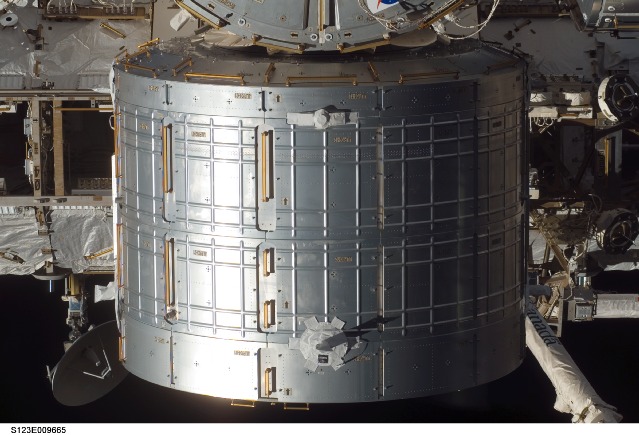
Source: NASA
|
| Launch: |
11 March 2008 at 6h28 UTC, from
Kennedy Space Center's LC-39A, by the Space
Shuttle.
The ELM-PS was installed on Node-2/Harmony
on 14 March 2008 at ~3h00 EDT. |
| Orbit: |
Part of the International Space Station. |
| Mission: |
The Japanese Experiment Logistics Module-Pressurized
Section (ELM-PS or JLP) is the first of the three components of the Japanese
Experiment Module (JEM) Kibo. The 8,387-kg module is Kibo’s storage facility
that provides stowage space for experiment payloads, samples and spare
items. On the space station, Kibo is the only experiment facility with
its own dedicated storage facility. The ELM-PS is a cylinder measuring
4.4 meters in diameter and 4.2 meters in length. |
| Source: |
Jonathan
Space Report No. 593
; Spacewarn No.
; National Space Science Data Center's
2007-0 ; SkyRocket's ; STS-123
Pres Kit |
|
|
.
Dextre / SPDM
| Spacecraft: |
SPDM stands for Special Purpose
Dexterous Manipulator |
| Chronologies: |
2008 payload #12 ; 2008 n/a ; 6,626th spacecraft. |
| Type: |
Space Station Component |
| Families: |
|
| Ranks: |
2,937th Civilian
spacecraft (30th Canadian) ; 30th
Canadian
spacecraft (30th Civilian). |
| Sponsor: |
Canadian Space Agency (CSA) |
|
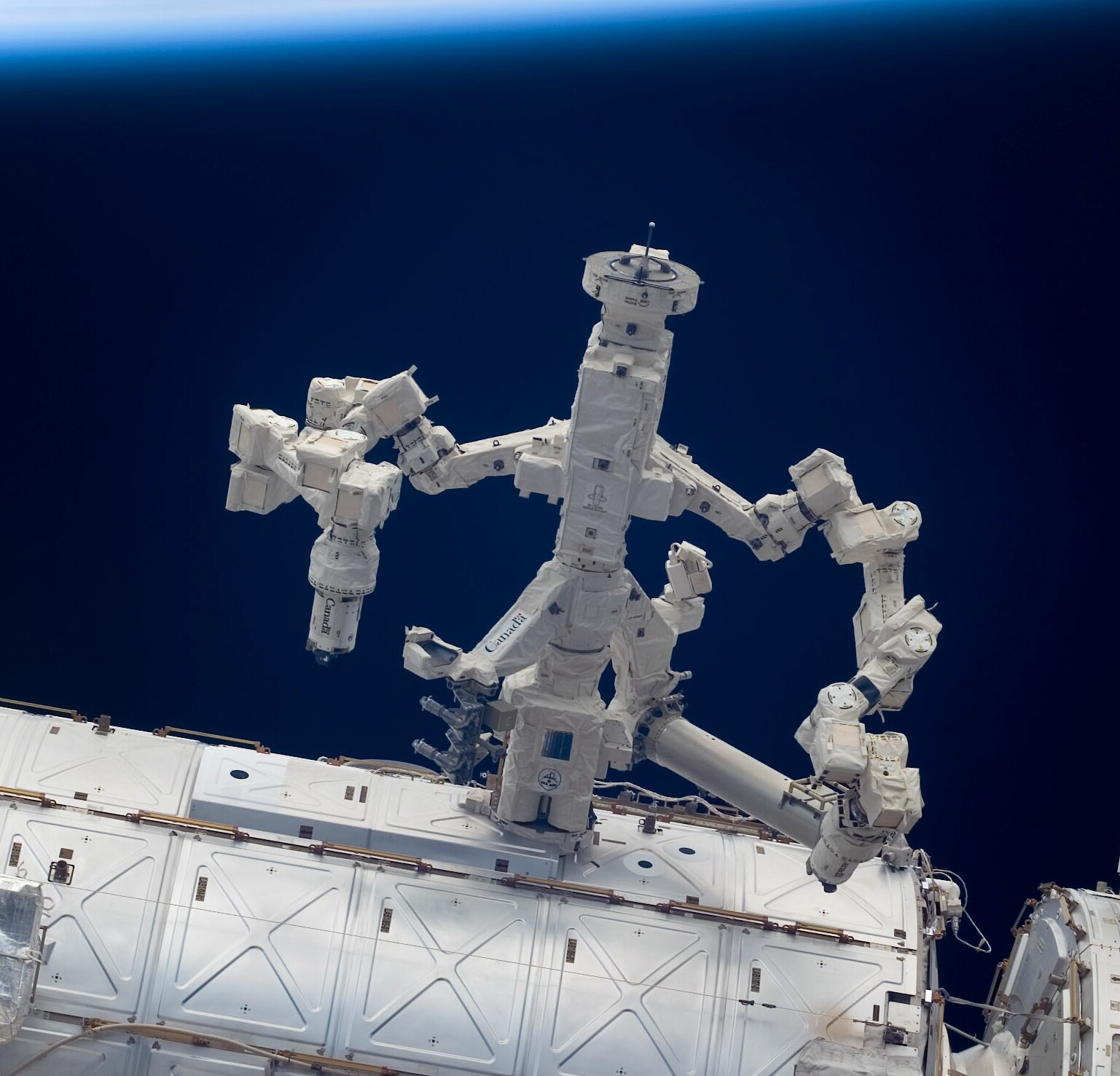
Source: NASA
|
Dextre in space (upper) and desing concepts
(below)
| Launch: |
11 March 2008 at 6h28 UTC, from
Kennedy Space Center's LC-39A, by the Space
Shuttle.
Dextre was stowed on the U.S. Lab grapple
fixture on 19 March 2008. |
| Orbit: |
Part of the International Space Station. |
| Mission: |
Dextre, the Special Purpose Dexterous Manipulator,
is a 1,560-kg agile robot that services outside the International Space
Station. It can pivot at the waist, and its shoulders support two identical
arms with seven joints that allow great degree of movement. The robot is
equipped with lights, video equipment, a stowage platform and four robotic
tools. At the end of each arm is an Orbital Replacement Unit/tool changeout
Mechanism that can hold a payload or tool with a vice-like grip. Dextre
can accomplish tasks that require high precision (it has a 2 milimetres
positioning accuracy) and a gentle touch (2.2 newtons) such as removing
and replacing station components, opening and closing covers and deploying
or retracting mechanisms. For several reasons, it is designed to move only
one arm at a time: to maintain stability, to harmonize activities with
Canadarm on the Shuttle and Canadarm2 on the Space Station, and to minimize
the possibility of self-collision.
Dextre is the third
and final component of the Mobile Servicing System developed by Canada
as its contribution to the ISS program. The first element is Canadarm2
installed in 2001 and the second is the Mobile Base System added in 2002.
Dextre can either be attached to the end of Canadarm2 or ride independently
on the Mobile Base System. |
| Source: |
Jonathan
Space Report No. ; Spacewarn
No. ; National Space Science
Data Center's 2007-0 ; SkyRocket's
; STS-123
Pres Kit ; CSA's Dextre
; |
|
|
.
NROL-28 (USA 200)
| Spacecraft: |
|
| Chronologies: |
2008 payload #13 ; 2008-010A ; 6,627th spacecraft. |
| Type: |
Electronic Intelligence (and also Missile
Early Warning) |
| Families: |
279th Electronic
Intelligence |
| Ranks: |
3,690th Military
spacecraft (1144th American) ; 1,771st American
spacecraft (1144th Military). |
| Sponsor: |
U.S. National Reconnaissance Office |
|
|
|
.
AMC 14
| Spacecraft: |
|
| Chronologies: |
2008 payload #14 ; 2008-011A (failure); 6,628th
spacecraft. |
| Type: |
Communications |
| Families: |
1,055th Civilian
Communications satellite ; |
| Ranks: |
2,938th Civilian
spacecraft (541stt Commercial); 541st Commercial
satellite (541st Civilian). |
| Sponsor: |
SES AMERICOM |
|
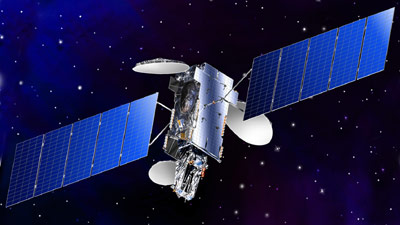 |
| Launch: |
14 March 2008 at 23h19 UTC, from
Baykonur Cosmodrome, by a Proton / Breeze
M. |
| Orbit: |
Failed to reach geostatonary orbit. |
| Mission: |
AMC-14 is a communications satellite with
32 Ku-band transponders that was scheduled to provide direct-to-home broadcast
services across the continental U.S., Mexico and Central America for EchoStar
Communications Corp., which has leased the entire capacity of the satellites
for its expected 15 years of service. But the satellite failed to reach
its planned geostationary orbit following the Breeze M upper stage engine
that shut down two minutes and 13 seconds earlier than planned.
Based on Lockheed
Martin’s A2100AX platform, AMC-14 is the 36th A2100 spacecraft designed
and built by Lockheed Martin for customers worldwide and the 17th for SES
companies. The craft also carries a demonstration receive active
phased array payload that allows coverage to be reshaped on orbit. |
| Source: |
Jonathan
Space Report No. 593
; Spacewarn No. 653
; National Space Science Data Center's
2007-0 ; SkyRocket's ; LMA's
12
Mar 08 ; Spaceflight Now's 15
Mar 08 ; |
|
|
.
Navstar 58 (USA 201)
| Spacecraft: |
Navstar SVN 48 / GPS IIR-19 |
| Chronologies: |
2008 payload #15 ; 2008-012A ; 6,629th spacecraft. |
| Type: |
Navigation |
| Families: |
374th Navigation
satellite ; 62nd Navstar U.S. navsat. |
| Ranks: |
3,691st Military
spacecraft (1145th American) ; 1,772nd American
spacecraft (1145th Military). |
| Sponsor: |
U.S. Department of Defense |
|
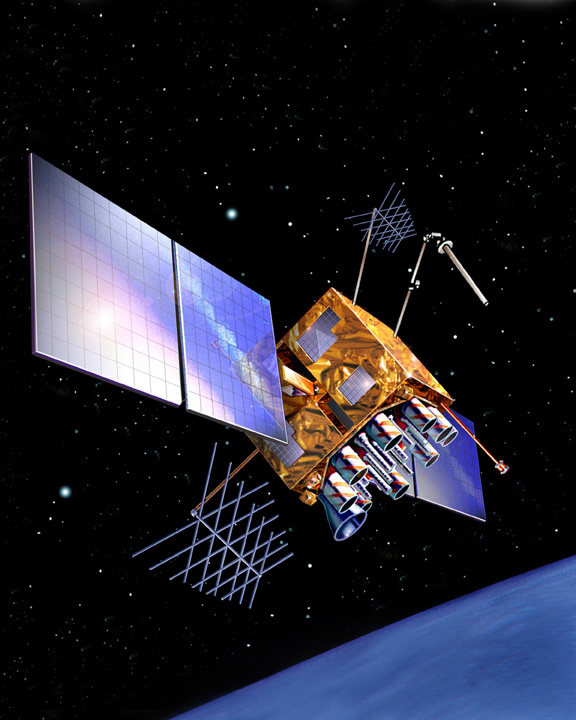
Source: Lockheed-Martin
|
| Launch: |
15 March 2008 at 6h10 UTC, from
Cape Canaveral Air Force Station's LC-17A, by Delta
II. |
| Orbit: |
|
| Mission: |
 Navstar
62, or GPS IIR-19M, is a 2,032-kg (1,070-kg in orbit) navigation satellite
designed to provide enhanced navigation capabilities for military and civilian
GPS users around the globe. It is the sixth in a line of eight GPS IIR
satellites that Lockheed Martin Navigation Systems has modernized for the
Global Positioning Systems Wing, Space and Missile Systems Center, Los
Angeles Air Force Base, Calif. (Lockheed Martin had built 21 GPS
IIR spacecraft and subsequently modernized eight of those spacecraft designated
Block IIR-M.) The satellite includes a modernized antenna panel that
provides increased signal power to receivers on the ground, two new military
signals for improved accuracy, enhanced encryption and anti-jamming capabilities
for the military, and a second civil signal that will provide users with
an open access signal on a different frequency. The GPS constellation provides
critical situational awareness and precision weapon guidance for the military
and supports a wide range of civil, scientific and commercial functions
– from air traffic control to the Internet – with precision location and
timing information. Navstar
62, or GPS IIR-19M, is a 2,032-kg (1,070-kg in orbit) navigation satellite
designed to provide enhanced navigation capabilities for military and civilian
GPS users around the globe. It is the sixth in a line of eight GPS IIR
satellites that Lockheed Martin Navigation Systems has modernized for the
Global Positioning Systems Wing, Space and Missile Systems Center, Los
Angeles Air Force Base, Calif. (Lockheed Martin had built 21 GPS
IIR spacecraft and subsequently modernized eight of those spacecraft designated
Block IIR-M.) The satellite includes a modernized antenna panel that
provides increased signal power to receivers on the ground, two new military
signals for improved accuracy, enhanced encryption and anti-jamming capabilities
for the military, and a second civil signal that will provide users with
an open access signal on a different frequency. The GPS constellation provides
critical situational awareness and precision weapon guidance for the military
and supports a wide range of civil, scientific and commercial functions
– from air traffic control to the Internet – with precision location and
timing information. |
| Source: |
Jonathan
Space Report No. 594
; Spacewarn No. 653
; National Space Science Data Center's
2007-0 ; SkyRocket's ; LMI's
GPS-IIR,
13
Mar 08 & 15
Mar 08 ; Spaceflgiht Now' s 15
Mar 08 ; |
|
|
.
DirecTV 11
| Spacecraft: |
|
| Chronologies: |
2008 payload #16 ; 2008-013A ; 6,630th spacecraft. |
| Type: |
Communications (Direct-to-Home) |
| Families: |
1,056th Civilian
Communications satellite ; 813th Geostationary
satellite. |
| Ranks: |
2,939th Civilian
spacecraft (542nd Commercial) ; 542nd
Commercial
satellite (542nd Civilian). |
| Sponsor: |
DirecTV |
|
|
|
.
SAR-Lupe 4
| Spacecraft: |
|
| Chronologies: |
2008 payload #17 ; 2008-014A ; 6,631st spacecraft. |
| Type: |
Radar Surveaillance |
| Families: |
1,201st Surveillance
satellite |
| Ranks: |
3,692nd Military
spacecraft (37th European) ; 296th European
spacecraft (37th Military). |
| Sponsor: |
German Ministry of Defense and the Federal
Office of Defense Technology and Procurement |
|
|
|
.
Soyuz TMA-12 / ISS 16S
| Spacecraft: |
Soyuz 11F732 (7K-STMA) No. 222 |
| Chronologies: |
2008 payload #18 ; 2008-015A ; 6,632nd spacecraft. |
| Type: |
Piloted Spaceship |
| Families: |
268th Human
Spaceflight (107th Soviet) ; 482nd Piloted
Spaceship (290th Russian) ; 79th ISS
Operation (47th Russian). |
| Ranks: |
2,940th Civilian
spacecraft (1055th Russian) ; 3,496th
Russian
spacecraft (1055th Civilian). |
| Sponsor: |
Russian Space Agency |
|
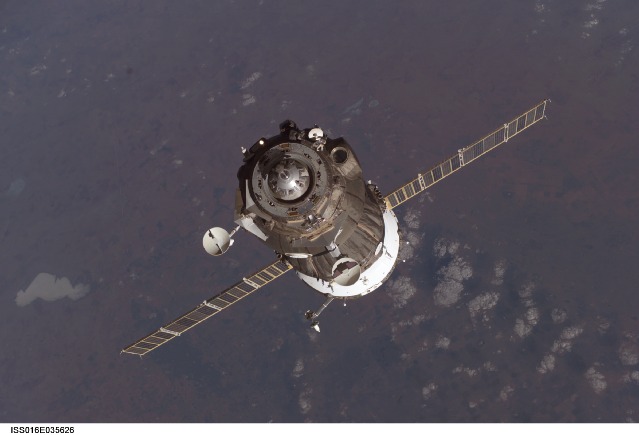
Source: NASA
|
| Launch: |
8 April 2008 at 11h16 UTC, from
Baykonur Cosmodrome's LC-1, by a Soyuz-FG. |
| Orbit: |
Initial: 189.6 km x 230.1 km x 56°
At ISS docking: 337.3 km x 338.7 km x 51.64°
x 91.29 min. |
| Mission: |
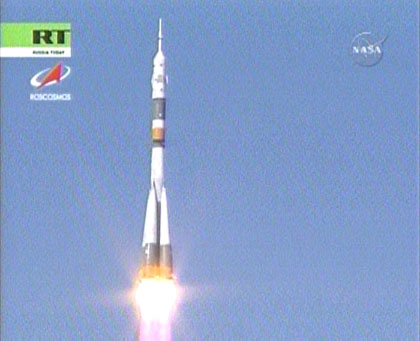 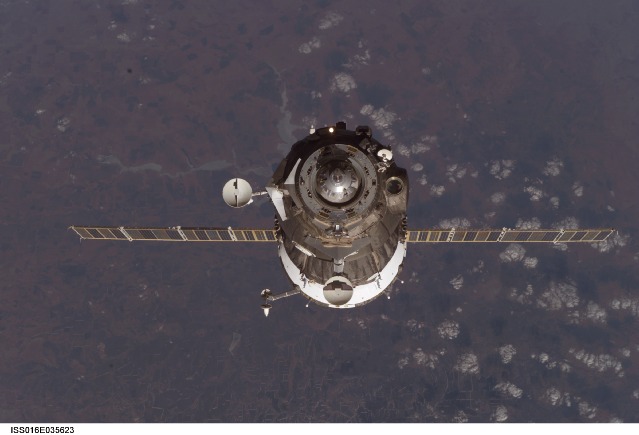 Soyuz
TMA-12 is a crew transport craft that carries Expedition 17 crew of Commander
Sergey Volkov and Flight Engineer Oleg Kononenko, as well as the 14th Visiting
Crewmember, Yi Soyeon, of South Korea, to the International Space Station.
The craft docked on the Docking Compartment port on 10 April 2008 at 8h57
EDT. Soyuz
TMA-12 is a crew transport craft that carries Expedition 17 crew of Commander
Sergey Volkov and Flight Engineer Oleg Kononenko, as well as the 14th Visiting
Crewmember, Yi Soyeon, of South Korea, to the International Space Station.
The craft docked on the Docking Compartment port on 10 April 2008 at 8h57
EDT. |
| Source: |
Jonathan
Space Report No. 595
; Spacewarn No. 654
; National Space Science Data Center's
2007-0 ; SkyRocket's ; |
|
|
.
ICO G1
| Spacecraft: |
|
| Chronologies: |
2008 payload #19 ; 2008-016A ; 6,633rd spacecraft. |
| Type: |
Communications (Mobile) |
| Families: |
1,057th Civilian
Communications satellite ; 814th Geostationary
satellite. |
| Ranks: |
2,941st Civilian
spacecraft (543rd Commercial) ; 543rd
Commercial
satellite (543rd Civilian). |
| Sponsor: |
ICO Global Communications |
|

Source: ICO
|
| Launch: |
14 April 2008 at 20h12 UTC, from
Cape Canaveral Air Force Station's SLC-41, by an Atlas
V. |
| Orbit: |
Geostationary at 92.85° West longitude. |
| Mission: |
ICO G1 is a 6,634-kg communications satellites
specially designed to deliver services to mobile users - interactive mobile
video, navigation and emergency assistance service - to the entire United
States. It is the biggest commercial satellite launched to date, measuring
more than 8 metres tall and spanning more than 30 metres with its solar
arrays and with an umbrella–like 12 meter reflector. Constructed by Space
Systems/Loral using the Loral 1300 platform, ICO G1 is the first commercial
satellite to utilize a ground-based beam forming system, which allows for
unprecedented flexibility. ICO G1 is thus an innovative next-generation
satellite with a planned mission life of 15 years. |
| Source: |
Jonathan
Space Report No. 595
; Spacewarn No. 654
; National Space Science Data Center's
2007-0 ; SkyRocket's ; ICO
14
Apr 08 ; SS/Loras's 28
Apr 08 ; |
|
|
.
C/NOFS / STP P00-3
| Spacecraft: |
C/NOFS stands for Communication/Navigation
Outage Forecasting System |
| Chronologies: |
2008 payload #20 ; 2008-017A ; 6,634th spacecraft. |
| Type: |
Science & Technology |
| Families: |
|
| Ranks: |
3,693rd Military
spacecraft (1146th American) ; 1,773rd American
spacecraft (1146th military). |
| Sponsor: |
U.S. Department of Defense |
|
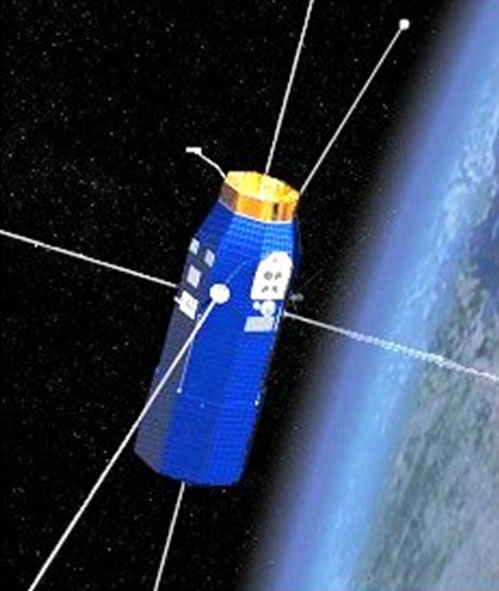
Source: KAF
|
| Launch: |
16 April 2008 at 16h52 UTC, from
Kwajalein atoll, by a
Pegasus XL.
(The L-1011 took off from the U.S. Army’s
Reagan Test Site in the Kwajalein Atoll, Republic of the Marshall Islands.) |
| Orbit: |
400 km x 850 km x 13° |
| Mission: |
C/NOFS, DoD Space Test Program's P00-3, is
a ~395 kg space weather forecasting satellite, the first-ever satellite
which observed the potential degradation of space communication, navigation
and surveillance systems due to ionospheric scintillations. Satellites
communication and navigation systems used by the Air Force and other DOD
agencies are susceptible to outages due to ionospheric disturbances (scintillations)
in the Earth’s equatorial region. C/NOFS is designed to help predict these
scintillations and to forecast outages in satellite communication links.
Built by General Dynamics, it is a joint project of the U.S. Air Force’s
Space and Missile Center’s Space Development and Test Wing and the Air
Force Research Laboratory Space Vehicles Directorate.
The Pegasus XL rocket
was released from the L-1011 carrier aircraft at approximately 13h00 EDT.
The satellite was accurately deployed into its targeted elliptical orbit
after an 8-minute powered flight sequence. The mission was the 25th consecutive
successful mission for the Pegasus program since 1997 and the 39th overall
flight since its introduction in 1990. |
| Source: |
Jonathan
Space Report No. 595
; Spacewarn No. 654
; National Space Science Data Center's
2007-0 ; SkyRocket's ; General
Dynamics's 16 Apr 08 ; OSC's
16
Apr 08 ; KAT's Doc
, |
|
|
.
Star One C2
| Spacecraft: |
|
| Chronologies: |
2008 payload #21 ; 2008-018A ; 6,635th spacecraft. |
| Type: |
Communications ; |
| Families: |
1,058th Civilian
Communications satellite ; 815th Geostationary
satellite. |
| Ranks: |
2,942nd Civilian
spacecraft (15th Brazilian) ; 15th
Brazilian
satellite (15th Civilian). |
| Sponsor: |
Brazil's Star One |
|
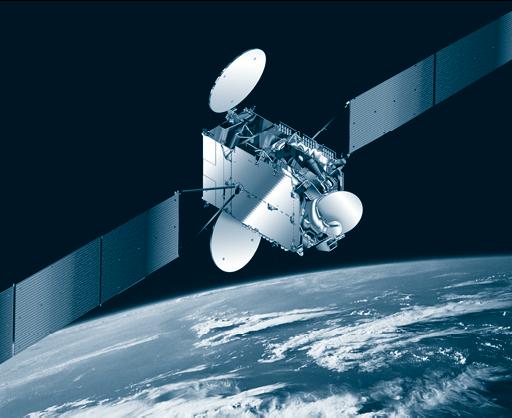 |
| Launch: |
18 April 2008 at 22h17 UTC, from
Kourou Space Center's ELA-3, by an Ariane
5 ECA. |
| Orbit: |
Geostationary at 70° West longitude. |
| Mission: |
 Star
One C2 is a 4,100-kg (1,750 kg dry mass) communications satellite fitted
with 28 C-band, 16 Ku-band and one X-band transponders to provide communications,
multimedia and broadband Internet services for South America. Measuring
4.0 x 3.2 x 2.4 metres (with a wingspan of 22.4 metres), the craft had
a 15-year lifespan. Built by Thales Alenia Space using a Spacebus 3000
B3 platform, the satellite was part of a turnkey contract for Brazilian
operator Star One, the largest regional satellite service operator in Latin
America. It is the eighth Brazilian satellite launched by an Ariane.
This 182nd Ariane launch (right), the 38th Ariane 5 launch. carries a total
payload of 7,762 kg, including 6,737 kg for two satellites. Star
One C2 is a 4,100-kg (1,750 kg dry mass) communications satellite fitted
with 28 C-band, 16 Ku-band and one X-band transponders to provide communications,
multimedia and broadband Internet services for South America. Measuring
4.0 x 3.2 x 2.4 metres (with a wingspan of 22.4 metres), the craft had
a 15-year lifespan. Built by Thales Alenia Space using a Spacebus 3000
B3 platform, the satellite was part of a turnkey contract for Brazilian
operator Star One, the largest regional satellite service operator in Latin
America. It is the eighth Brazilian satellite launched by an Ariane.
This 182nd Ariane launch (right), the 38th Ariane 5 launch. carries a total
payload of 7,762 kg, including 6,737 kg for two satellites. |
| Source: |
Jonathan
Space Report No. 595
; Spacewarn No. 654
; National Space Science Data Center's
2007-0 ; SkyRocket's ; Arianespace's
19
Apr 08 & Press
Kit ; |
|
|
.
VINASAT-1
| Spacecraft: |
|
| Chronologies: |
2008 payload #22 ; 2008-018B ; 6,636th spacecraft. |
| Type: |
Communication |
| Families: |
1,059th Civilian
Communications satellite ; 816th Geostationary
satellite. |
| Ranks: |
2,943rd Civilian
spacecraft (1st Vietnamese) ; 1st
Vietnamese
satellite (1st Civilian). |
| Sponsor: |
Vietnam Posts and Telecommunications Group |
|
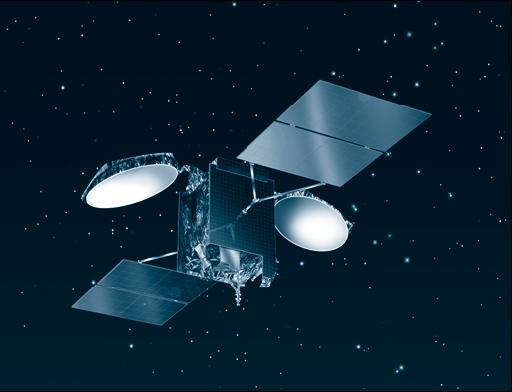 |
| Launch: |
18 April 2008 at 22h17 UTC, from
Kourou Space Center's ELA-3, by an Ariane
5 ECA. |
| Orbit: |
Geostationary at 132° East longitude. |
| Mission: |
VINASAT-1 is a 2,637-kg communications satellite
carrying 12 Ku-band and 8 C-band transponders. As Vietnam’s first communications
satellite, it provides radio, television and telephone transmission services
throughout the country. Built by Lockheed Martin Commercial Space Systems,
using an A2100A platform, it measures 3.8 x 1.9 x 1.9 metres (with an orbital
wingspan of 14.65 metres) with a design life exceeding 15 years. |
| Source: |
Jonathan
Space Report No. 595
; Spacewarn No. 654
; National Space Science Data Center's
2007-0 ; SkyRocket's ; Arianespace's
19
Apr 08 & Press
Kit ; |
|
|
.
Tianlian I
| Spacecraft: |
|
| Chronologies: |
2008 payload #23 ; 2008-019A ; 6,637th spacecraft. |
| Type: |
Communication (data relay) |
| Families: |
1,060th Civilian
Communications satellite ; 817th Geostationary
satellite. |
| Ranks: |
2,944th Civilian
spacecraft (59th Chinese) ; 113th
Chinese
spacecraft (59th Civilian). |
| Sponsor: |
China |
|
|
| Launch: |
25 April 2008 at 22h16
UTC, from Xichang Satellite Launch Center, by a Chang
Zheng 3C. |
| Orbit: |
Geostationary |
| Mission: |
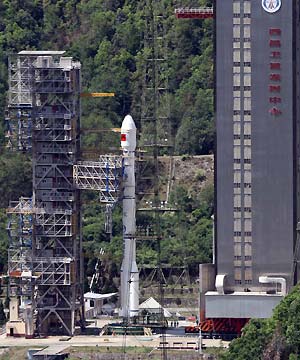  Tianlian
I is China first data-relay satellite. It will be used to increase communication
time with the Shenzhou VII spaceship to be launched in the second half
of 2008. The craft was developed by the China Aerospace Science and
Technology Corporation. According to China report, the launch is the 105th
mission of China's Long March series of rockets, but the first mission
of the Long March-3C carrier rocket. (China had planned 10 space launches
this year.) Tianlian
I is China first data-relay satellite. It will be used to increase communication
time with the Shenzhou VII spaceship to be launched in the second half
of 2008. The craft was developed by the China Aerospace Science and
Technology Corporation. According to China report, the launch is the 105th
mission of China's Long March series of rockets, but the first mission
of the Long March-3C carrier rocket. (China had planned 10 space launches
this year.) |
| Source: |
Jonathan
Space Report No. 595
; Spacewarn No. 654
; National Space Science Data Center's
2007-0 ; SkyRocket's ; China
Daily, 26
Apr 08 ; People's Daily's 26
Apr 08 ; |
|
|
.
GIOVE-B
| Spacecraft: |
GIOVE stands for Galileo In-Orbit
Validation Element |
| Chronologies: |
2008 payload #24 ; 2008-020A ; 6,638th spacecraft. |
| Type: |
Technology (Navigation) |
| Families: |
|
| Ranks: |
2,945th Civilian
spacecraft (257th European) ; 293rd
European
spacecraft (257th Civilian). |
| Sponsor: |
European Space Agency, the European Commission
and Eurocontrol. |
|
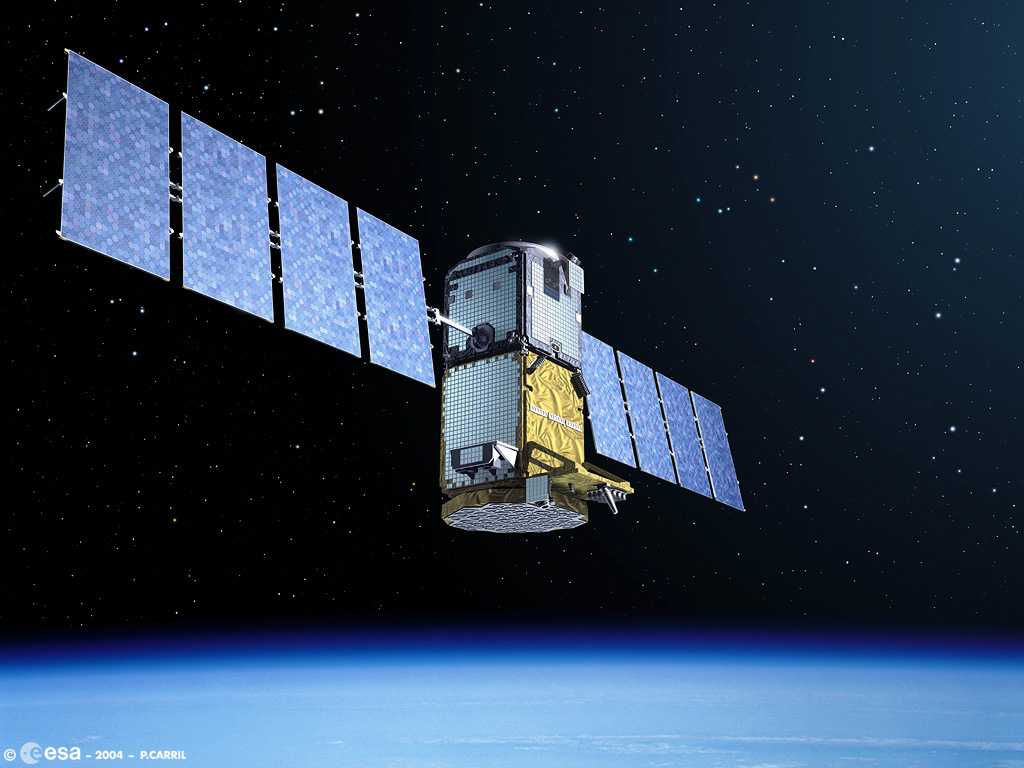 |
| Launch: |
26 April 2008 at 22h16 UTC, from
Baykonur Cosmodrome, by a Soyuz FG/Fregat. |
| Orbit: |
Circular at about 23,200 km x 56°. |
| Mission: |
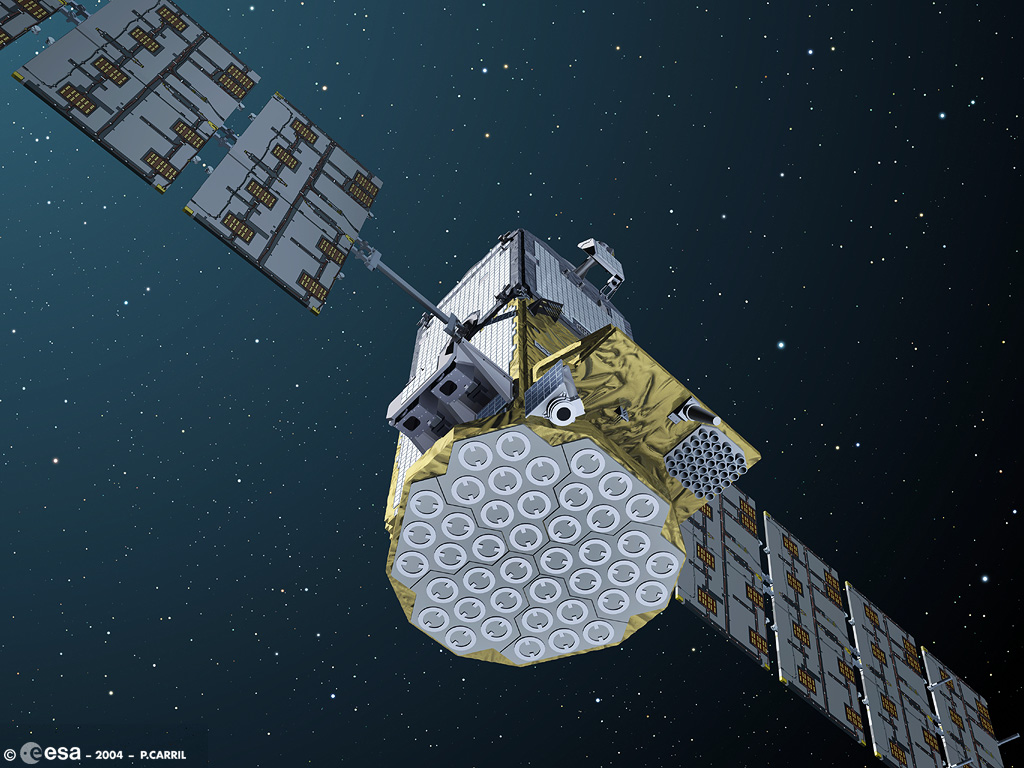  GIOVE-B
is a 500-kg navigation demonstration satellite for the Galileo system.
It continue GIOVE-A demonstration
of critical technologies. Like its predecessor, it carries two redundant
rubidium atomic clocks, each with a stability of 10 nanoseconds per day.
It also features an even more accurate payload: the Passive Hydrogen Maser
(PHM), with stability better than 1 nanosecond per day. The first of its
kind into space, this is now the most stable clock operating in Earth orbit.
Two PHMs will be used as primary clocks onboard operational Galileo satellites,
with two rubidium clocks serving as back-up. GIOVE-B also incorporates
a radiation-monitoring payload to characterise the space environment at
the altitude of the Galileo constellation, as well as a laser retroreflector
for high-accuracy laser ranging. The satellite was built by a team
led by Astrium GmbH, with Thales Alenia Space. The next step in the Galileo
programme will be the launch of four operational satellites to validate
the basic Galileo space and related ground segment by 2010. GIOVE-B
is a 500-kg navigation demonstration satellite for the Galileo system.
It continue GIOVE-A demonstration
of critical technologies. Like its predecessor, it carries two redundant
rubidium atomic clocks, each with a stability of 10 nanoseconds per day.
It also features an even more accurate payload: the Passive Hydrogen Maser
(PHM), with stability better than 1 nanosecond per day. The first of its
kind into space, this is now the most stable clock operating in Earth orbit.
Two PHMs will be used as primary clocks onboard operational Galileo satellites,
with two rubidium clocks serving as back-up. GIOVE-B also incorporates
a radiation-monitoring payload to characterise the space environment at
the altitude of the Galileo constellation, as well as a laser retroreflector
for high-accuracy laser ranging. The satellite was built by a team
led by Astrium GmbH, with Thales Alenia Space. The next step in the Galileo
programme will be the launch of four operational satellites to validate
the basic Galileo space and related ground segment by 2010. |
| Source: |
Jonathan
Space Report No. 596
; Spacewarn No. 654
; National Space Science Data Center's
2007-0 ; SkyRocket's ; ESA's
GIOVE-B,
26
Apr 08 & 27
Apr 08 ; |
|
|
.
CARTOSAT-2A
| Spacecraft: |
|
| Chronologies: |
2008 payload #25 ; 2008-021A ; 6,639th spacecraft. |
| Type: |
Earth Remoste Sensing |
| Families: |
119th Earth
Remoste Sensing.(17th Indian). |
| Ranks: |
2,946th Civilian
spacecraft (49th Indian) ; 49th
Indian
spacecraft (49th Civilian). |
| Sponsor: |
Indian Space Research Organisation |
|
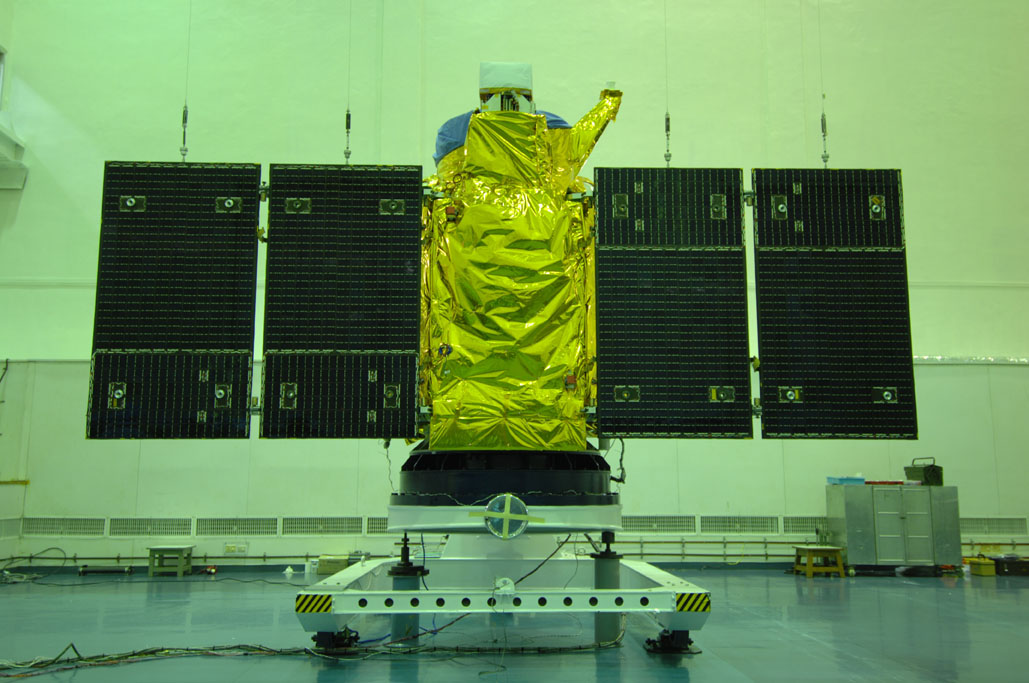 Source: ISRO
Source: ISRO
|
Spacecrafts launched by the PSLV-C9 (Source:
ISRO)
| Launch: |
28 April 2008 at 3h53:51 UTC,
from Sriharikota's Satish Dhawan Space Centre SHAR, by a PSLV. |
| Orbit: |
|
| Mission: |
CARTOSAT-2A is a 650-kg Earth-remote sensing
satellite with a spatial resolution of about one metre and swath of 9.6
km. The satellite carries a panchromatic camera capable of taking black-and-white
pictures in the visible region of electromagnetic spectrum. The craft is
steerable along as well as across the direction of its movement to facilitate
imaging of any area more frequently. High-resolution data from CARTOSAT-2A
will be used for large-scale mapping of urban and rural development. |
| Source: |
Jonathan
Space Report No. 596
; Spacewarn No. 654
; National Space Science Data Center's
2007-0 ; SkyRocket's ; ISRO's
28
Apr 08 & CARTOSAT-2A
; SpaceflightNow's 28
Apr 08 ; |
|
|
.
IMS-1 / Indian Mini
Satellite
| Spacecraft: |
|
| Chronologies: |
2008 payload #26 ; 2008-021B ; 6,640th spacecraft. |
| Type: |
Earth Remote Sensing |
| Families: |
120th Earth
Remoste Sensing.(18th Indian). |
| Ranks: |
2,947th Civilian
spacecraft (50th Indian) ; 50th
Indian
spacecraft (50th Civilian). |
| Sponsor: |
Indian Space Research Organisation |
|
|
| Launch: |
28 April 2008 at 3h53:51 UTC,
from Sriharikota's Satish Dhawan Space Centre SHAR, by a PSLV. |
| Orbit: |
|
| Mission: |
IMS-1 is a 83-kg satellite which incorporates
many new technologies for remote sensing applications and has miniaturised
subsystems. It carries two remote sensing payloads: a Multi-spectral camera
and a Hyper-spectral camera, operating in the visible and near infrared
regions of the electromagnetic spectrum. The spatial resolution of the
first camera is 37 metre with a swath of 151 km, while that of the second
camera is about 506 metre with a swath of about 130 km. The data from this
mission will be made available to interested space agencies and student
community from developing countries to provide necessary impetus to capacity
building in using satellite data. The versatile IMS-1 has been specifically
developed to carry different payloads in future without significant changes
in it and has a design life time of two years. |
| Source: |
Jonathan
Space Report No. 596
; Spacewarn No. 654
; National Space Science Data Center's
2007-0 ; SkyRocket's ; ISRO's
28
Apr 08 & IMS-1
; |
|
|
.
NLS-5
| Spacecraft: |
|
| Chronologies: |
2008 payload #27 ; 2008-021 ; 6,641st spacecraft. |
| Type: |
Amateur/Student (Technology) |
| Families: |
111th Ameteur/Student
Satellite ; |
| Ranks: |
2,948th Civilian
spacecraft (93rd
Amateur) ; 93rd Amateur
spacecraft (Canadian). |
| Sponsor: |
University of Toronto's Spaceflight Laboratory,
Canada |
|
|
|
.
RUBIN-8
| Spacecraft: |
|
| Chronologies: |
2008 payload #28 ; 2008-021 ; 6,642nd spacecraft. |
| Type: |
Amateur/Student (Technology) |
| Families: |
112th Ameteur/Student
Satellite ; |
| Ranks: |
2,949th Civilian
spacecraft (258th European) ; 295th European
(258th Civilian). |
| Sponsor: |
COSMOS International, Germany |
|
|
|
.
CAN-X2
| Spacecraft: |
|
| Chronologies: |
2008 payload #29 ; 2008-021 ; 6,643rd spacecraft. |
| Type: |
Amateur/Student (Technology) |
| Families: |
113th Ameteur/Student
Satellite ; |
| Ranks: |
2,950th Civilian
spacecraft (94th Amateur) ; 94th Amateur
spacecraft (Canadian). |
| Sponsor: |
University of Toronto's Spaceflight Laboratory,
Canada |
|
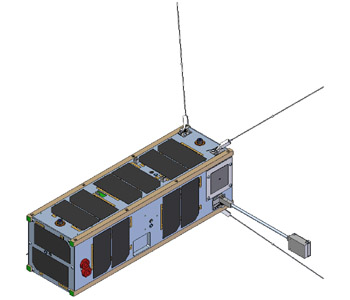
Source: U.
of Toronto
|
|
.
DELPHI-C3
| Spacecraft: |
|
| Chronologies: |
2008 payload #30 ; 2008-021 ; 6,644th spacecraft. |
| Type: |
Amateur/Student (Technology) |
| Families: |
114th Ameteur/Student
Satellite ; |
| Ranks: |
2,951st Civilian
spacecraft (95th Amateur) ; 95th Amateur
spacecraft. |
| Sponsor: |
Delfi's Technical University, Netherlands |
|
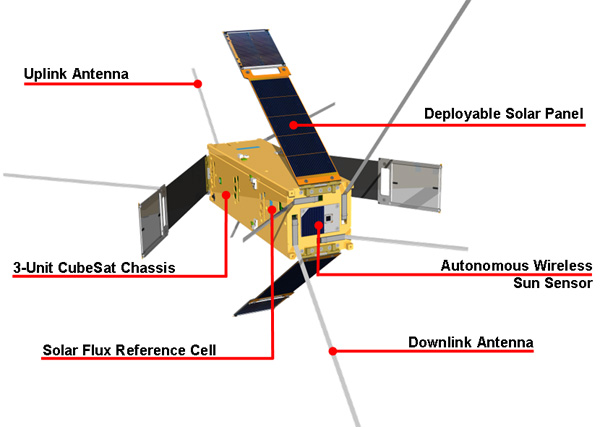 |
|
.
CUTE 1.7
| Spacecraft: |
|
| Chronologies: |
2008 payload #31 ; 2008-021 ; 6,645th spacecraft. |
| Type: |
Amateur/Student (Technology) |
| Families: |
115th Ameteur/Student
Satellite ; |
| Ranks: |
2,952nd Civilian
spacecraft (96th Amateur) ; 96th Amateur
spacecraft |
| Sponsor: |
Tokyo Institute of Technology, Japan |
|
|
|
.
SEEDS
| Spacecraft: |
|
| Chronologies: |
2008 payload #32 ; 2008-021 ; 6,646th spacecraft. |
| Type: |
Amateur/Student (Technology) |
| Families: |
116th Ameteur/Student
Satellite ; |
| Ranks: |
2,953rd Civilian
spacecraft (97th Amateur) ; 97th Amateur
spacecraft |
| Sponsor: |
Nihon University, Japan |
|
|
|
.
AAUSAT-II
| Spacecraft: |
|
| Chronologies: |
2008 payload #33 ; 2008-021 ; 6,647th spacecraft. |
| Type: |
Amateur/Student (Technology) |
| Families: |
117th Ameteur/Student
Satellite ; |
| Ranks: |
2,954th Civilian
spacecraft (98th Amateur) ; 98th Amateur
spacecraft |
| Sponsor: |
Aalborg University, Denmark |
|
|
|
.
COMPASS-1
| Spacecraft: |
|
| Chronologies: |
2008 payload #34 ; 2008-021 ; 6,648th spacecraft. |
| Type: |
Amateur/Student (Technology) |
| Families: |
118th Ameteur/Student
Satellite ; |
| Ranks: |
2,955th Civilian
spacecraft (99th Amateur) ; 99th Amateur
spacecraft |
| Sponsor: |
Aachen's University of Applied Science, Germany |
|
|
|
.
Amos 3
| Spacecraft: |
|
| Chronologies: |
2008 payload #35 ; 2008-022A ; 6,649th spacecraft. |
| Type: |
Communications |
| Families: |
1,061th Civilian
Communications satellite ; 818th Geostationary
Satellite. |
| Ranks: |
2,956th Civilian
Spacecraft (4th Israelian) ; 12th
Israelian
Satellite (4th Civilian). |
| Sponsor: |
Israel's Space Communications (Spacecom)
Company |
|
|
| Launch: |
28 April 2008 at 5h00 UTC, from
Baykonur Cosmodrome's LC-45, by a Zenit
3SLB. |
| Orbit: |
Geostationary at 4° West longitude. |
| Mission: |
Amos 3 is a 1,270-kg communications satellite
that carries 12 Ku-band and 2 Ka-band transponders to service Europe, Middle-East
and North America. It replaces Amos
1 with an expected service life of over 18 years, following the technical/financial
success of the two previous Amos. (On 16 May 2008, Amos 1 celebrate
its 12 years of operation in orbit, while being planned for less than 11
years.) For ensuring the continuity of services, Amos 3 is placed
at the same location. It is the first Western satellite to be placed directly
into geostationary orbit, using the Zenit/Block-DM, which unable to launch
a satellite lighter than its predecessor and having 6 years longer service
life (about 18 years). Other advantages inclues: less fuel (420 kg versus
760 kg), more communication payload (250 kg versus 160 kg), more channels,
more frequencies and more income for more service years. The craft was
built by Israel Aerospace Industries for Space Communications Company, |
| Source: |
Jonathan
Space Report No. 596
; Spacewarn No. 654
; National Space Science Data Center's
2007-0 ; SkyRocket's ; SpaceflightNow's
28
Apr 08 ; Sea Launch's 28
Apr 08 ; IAI's 28
Apr 08 & Amos
3 Press Kit ; RST Energia's 28
Apr 08 ; |
|
Launch of the Zenit 3SLB with Amos 3
satellite (Source: RSC
Energia)
|
.
Progress M-64 / ISS
29P
| Spacecraft: |
Progress M (7K-TGM) No. 364 |
| Chronologies: |
2008 payload #36 ; 2008-023A ; 6,650th spacecraft. |
| Type: |
Cargo delivery to the International Space
Station |
| Families: |
483rd Piloted
Spaceship (291st Russian) ; 119th Progress
Cargoship ; 74th ISS Operation (48th
Russian).. |
| Ranks: |
2,957th Civilian
Spacecraft (1056th Russan) ; 3,497th
Russian
Spacecraft (1056th Civilian). |
| Sponsor: |
Russian Federal Space Agency |
|
|
Progress M-63 in preparation. (Photos:
RSC
Eneregia)
| Launch: |
14 May 2008 at 20h22 UTC, from
Baykonur Cosmodrome's LC-1, by a Soyuz
U. |
| Orbit: |
Initial: 193.9 km x 245.9 km x 51.65°
x 88.57 min.
At docking: 338.0 km x 356.1 km x 51.6°
x 91.28 min. |
| Deorbit: |
|
| Mission: |
 Progress
M-64 is a cargo transport ship that deliver more than 2.3 tons of various
cargo items - oxygen, water and food supplies, propellant, consumables,
etc. - to the International Space Sration. It also carries Sokol KV-2 spacesuit
and equipment to be installed in Zvezda module to support a new Russian
research module. Following a two-day free-flight, it docked in the
automatic mode on port of the FGB Zarya Progress M-64 is the 29th
Russian cargo vehicle launched toward ISS and the 118th Progress ever launched.
(Photo at right, ISS as viewed by the approching Progress M-64.) Progress
M-64 is a cargo transport ship that deliver more than 2.3 tons of various
cargo items - oxygen, water and food supplies, propellant, consumables,
etc. - to the International Space Sration. It also carries Sokol KV-2 spacesuit
and equipment to be installed in Zvezda module to support a new Russian
research module. Following a two-day free-flight, it docked in the
automatic mode on port of the FGB Zarya Progress M-64 is the 29th
Russian cargo vehicle launched toward ISS and the 118th Progress ever launched.
(Photo at right, ISS as viewed by the approching Progress M-64.) |
| Source: |
Jonathan
Space Report No. 596
; Spacewarn No. 655
; National Space Science Data Center's
2007-0 ; SkyRocket's ; RSC
Energia's 15
May 08 & 17
May 08 ; |
|
Launch of Progress M-64 by a Soyuz U.
(Photos: RSC
Energia)
|
.
Galaxy 18
| Spacecraft: |
|
| Chronologies: |
2008 payload #37 ; 2008-024A ; 6,651st spacecraft. |
| Type: |
Communications |
| Families: |
1,062nd Civilian
Communications satellite ; 819th Geostationary
Satellite. |
| Ranks: |
2,958th Civilian
Spacecraft (544th Commercial) ; 544th
Commercial
satellite (544th Civilian). |
| Sponsor: |
Intelsat |
|

Source: SS/Loral
|
| Launch: |
21 May 2008 at 9h43 UTC, from
Odysseay Launch Platform, by a Zenit-3SL. |
| Orbit: |
Geostationary at 123° West longitude. |
| Mission: |
Galaxy 18 is a 4,650-kg communications satellites
with a hybrid payload of 24 high-power Ku-band and 24 C-band used for Fixed
Satellite Services for advanced cable television, data and telecommunications
services throughout North America, Alaska, Hawaii, Mexico and Puerto Rico..
It joins Intelsat's coveted North American cable community within its Galaxy
fleet comprised of 16 other satellites that cover North America, Central
America and the Caribbean. Built by Space Systems/Loral, the spacecraft
has a planned mission life of 15 years, and is designed based on SS/L’s
1300 platform. Galaxy 18 is the 42nd Space Systems/Loral satellite built
for Intelsat. |
| Source: |
Jonathan
Space Report No. 596
; Spacewarn No. 655
; National Space Science Data Center's
2007-0 ; Intelsat's 21
May 08 ; Loral's 21
May 08 ; SkyRocket's
; |
|
|
.
Kosmos 2437 / Rodnik
#2
| Spacecraft: |
Rodnik |
| Chronologies: |
2008 payload #38 ; 2008-025A ; 6,652nd spacecraft. |
| Type: |
Communications (strre-dump) |
| Families: |
779th Military
Communications Satellite ; |
| Ranks: |
3,694th Military
Spacecraft (2,442nd Russian) ; 3,498th
Russian
Spacecraft (2,442nd Military). |
| Sponsor: |
Russian Defense Ministry |
|
|
|
.
Kosmos 2438 / Rodnik
#3
| Spacecraft: |
Rodnik |
| Chronologies: |
2008 payload #39 ; 2008-025B ; 6,653rd spacecraft. |
| Type: |
Communications (strre-dump) |
| Families: |
780th Military
Communications Satellite ; |
| Ranks: |
3,695th Military
Spacecraft (2,443rd Russian) ; 3,499th
Russian
Spacecraft (2,443rd Military). |
| Sponsor: |
Russian Defense Ministry |
|
|
|
.
Kosmos 2439 / Rodnik
#4
| Spacecraft: |
Rodnik |
| Chronologies: |
2008 payload #40 ; 2008-025C ; 6,654th spacecraft. |
| Type: |
Communications (strre-dump) |
| Families: |
781st Military
Communications Satellite ; |
| Ranks: |
3,696th Military
Spacecraft (2,444th Russian) ; 3,500th
Russian
Spacecraft (2,444th Military). |
| Sponsor: |
Russian Defense Ministry |
|
|
|
.
Yubileynyy
| Spacecraft: |
|
| Chronologies: |
2008 payload #41 ; 2008-025D ; 6,655th spacecraft. |
| Type: |
Amateur/student |
| Families: |
119th Ameteur/Student
Satellite ; |
| Ranks: |
2,959th Civilian
Spacecraft (1,057th Russian) ; 3,501st Russian
Spacecraft (1,057th Civilian). |
| Sponsor: |
Russia |
|
|
|
.
FY-3A / Feng Yun 3A
| Spacecraft: |
|
| Chronologies: |
2008 payload #42 ; 2008-026A ; 6,656th spacecraft. |
| Type: |
Meteorology |
| Families: |
170th Civilian
Meteorological Satellite (9th Chinese) ; |
| Ranks: |
2,960th Civilian
spacecraft (60th Chinese) ; 114th
Chinese
spacecraft (60th Civilian). |
| Sponsor: |
China Meteorological Administration |
|
|
| Launch: |
27 May 2008 at 3h02 UTC,
from Taiyuan Satellite Launch Center, by a Chang
Zheng 3A |
| Orbit: |
|
| Mission: |
Fengyun 3A is 2,295-kg meteorological satellite
that carries out three-dimensional, all-weather, multi-spectrum quantitative
detection and acquire data from ground surfaces, oceans and space to facilitate
precise weather forecasting. It is equipped with advanced detectors such
as an infrared scan actinograph and a microwave formatter. The satellite
sends back images with a spatial resolution of 250 metres and its temperature
sensitivity will be in the region of 0.1 degree F. Currently, the highest
spatial resolution of existing Chinese satellites is 1.1 km. Sinch the
craft provides accurate and timely information about weather changes during
the Beijing Olympic Games and works with the existing FY-2; it is considered
by China as its “second weather satellite for the Olympic Games.”
The satellite was developed by the Shanghai Academy of Space flight Technology
for the China Meteorological Administration (CMA). China has launched
nine meteorological satellites since the 1988 (4 Fengyun-1 series and 4
Fengyun-2 series, plus thiss firt Fengyun-3) and plans to launch another
22 meteorological satellites by 2020, including four more from the Fengyun-2
series, 12 from the Fengyun-3 series and six from the Fengyun-4 series. |
| Notes: |
Contracts were signed on 18 September 2002
for the development of Fengyun 3 meteorological satellite. This will be
China's second-generation sun-synchronous orbiting) satellite that will
provide global weather information. |
| Source: |
Jonathan
Space Report No. 596
; Spacewarn No. 655
; National Space Science Data Center's
2007-0 ; China Daily's 27
May 08 & 28
May 08 ; SpaceflightNow's 27
May 08 ; Xinhua’s 18
Sep 02 ; SkyRocket's
; |
The FY-3A launched by a Chang Zheng 3A
|
|
.
STS-124 / ISS 1J
| Spacecraft: |
Space Shuttle's 123rd flight,
Discovery's 35th flight and 26th Shuttle flight to ISS. . |
| Chronologies: |
2008 payload #43 ; 2008-027A ; 6,657th spacecraft. |
| Type: |
Piloted Spaceship |
| Families: |
75th ISS
Operation (26th American) |
| Ranks: |
2,961st Civilian
spacecraft (628th American) ; 1774th American
(628th Civilian) |
| Sponsor: |
NASA |
|
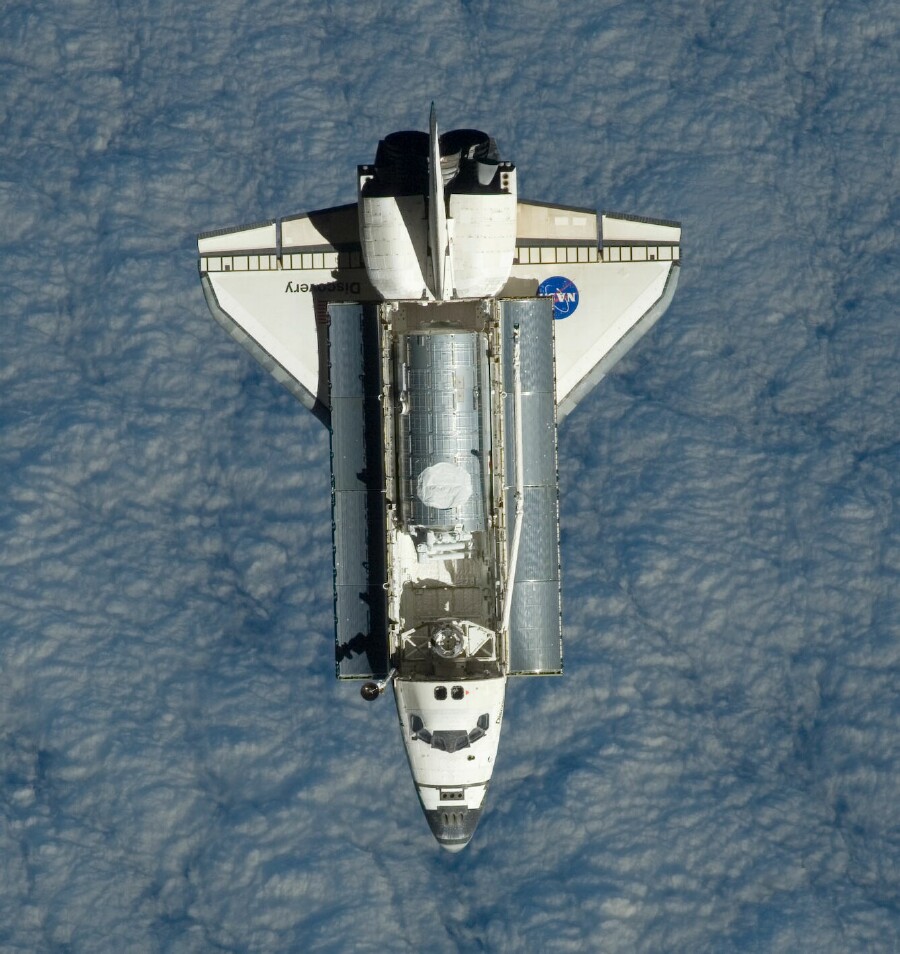
Source: NASA
|
|
Space Shuttle STS-124 Launched (Source:
NASA KSC)
|
|
The International Space Station at the
completion of STS-124 and anatomy of the principal components of the station.
(Photos S124-E-010042,
S124-E-009968,
S124-E-009973.&
S124-E-010186)
.
Kibo Pressurized Module
(JPM)
| Spacecraft: |
|
| Chronologies: |
2008 payload #44 ; 2008 n/a ; 6,658th spacecraft. |
| Type: |
Space Sataion Component |
| Families: |
|
| Ranks: |
2,962nd Civilian
spacecraft (112th Japanese) ; 120th Japanese
(112th Civilian). |
| Sponsor: |
Japan Aerospace Exploration Agency (JAXA |
|
|
|
..
Zhongxing 9 (Chinasat
9)
| Spacecraft: |
|
| Chronologies: |
2008 payload #45 ; 2008-028A ; 6,659th spacecraft. |
| Type: |
Communications (DBS) |
| Families: |
|
| Ranks: |
2,962nd Civilian
spacecraft (61st Chinese) :115th Chinese
(61st Civilian). |
| Sponsor: |
China Satcom |
|
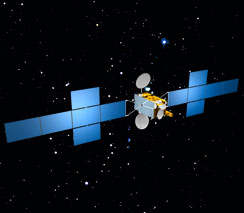 |
| Launch: |
9 June 2008 at 12h15 UTC UTC,
from Xichang Satellite Launch Center, by a Chang
Zheng 3B. |
| Orbit: |
Geostationary at 92.2° East longitude. |
| Mission: |
Zhongxing-9 is a communications satelite
used for live television broadcast to be use during the Beijing Olympic
Games in August. The craft was ordered by China Satcom from the France-based
Thales Alenia Space, |
| Source: |
Jonathan
Space Report No. 597
; Spacewarn No. 656
; National Space Science Data Center's
2007-0 ; China Daily's 9
Jun 08 ; SkyRocket's
; |
The launch of Zhongxing 9 onboard a Chang
Zheng rocket.
|
|
..
GLAST
| Spacecraft: |
GLAST stands for Gamma-ray Large
Area Space Telescope |
| Chronologies: |
2008 payload #46 ; 2008-029A ; 6,660th spacecraft. |
| Type: |
Astronomy |
| Families: |
|
| Ranks: |
2,964th Civilian
spacecraft (629th American) ; 1775th American
(629th Civilian). |
| Sponsor: |
NASA |
|

|
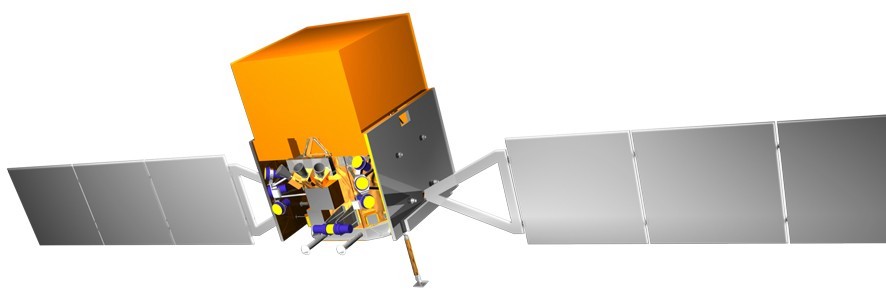
| Launch: |
11 June 2008 at 16h05 UTC, from
Cape Canaveral Air Force Station's LC-17B, by a Delta
2920H-10 . |
| Orbit: |
542 km x 561 km x 25.6° |
| Mission: |
GLAST is an astronomy satellite that studies
gamma rays in a range of energies from thousands to hundreds of billions
of times more energetic than the light visible to the human eye.
Its main instrument is the Large Area Telescope which could view 20% of
the sky at a time with a spatial resolution of a few arcminutes - unprecedented
in a high energy gamma-ray satellite. LAT is a successor to COS-B and CGRO-EGRET,
which represent a considerable improvement over its successful predecessor,
the Compton Gamma Ray Observatory. A secondary experiment, the Gamma Burst
Monitor is a successor to CGRO-BATSE. GLAST focus on studying the most
energetic objects and phenomena in the Universe. it observes gamma-ray
sources near the edge of the visible Universe. Gamma rays detected by GLAST
will originate near the otherwise obscured central regions of exotic objects
like supermassive black holes, pulsars and gamma-ray bursts. The
25.6 deg inclination is unusual and reduced the amount of time spent in
the South Atlantic Anomaly improves the sensitivity of the observations.The
mission is being designed for a lifetime of 5 years, with a goal of 10
years of operations. |
| Source: |
Jonathan
Space Report No. 597
; Spacewarn No. 656
; National Space Science Data Center's
2007-0 ;NASA's GLAST ; SkyRocket's
; NASA's 2010-2014 NASA
News Releases ; |
|
|
.
Skynet 5C
| Spacecraft: |
|
| Chronologies: |
2008 payload #47 ; 2008-030A ; 6,661st spacecraft. |
| Type: |
Communications |
| Families: |
|
| Ranks: |
3,697th Military
spacecraft (38th European) ; 298th European
spacecraft (38th Military) |
| Sponsor: |
British Ministry of Defence |
|
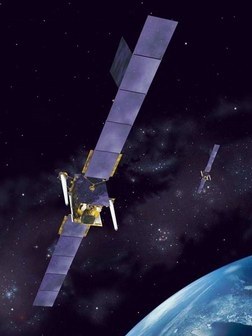
|
| Launch: |
12 June 2008 at 22h05 UTC, from
Kourou Space Center's ELA-3, by an Ariane
5 ECA. |
| Orbit: |
Geostationary at 17.8° West longitude. |
| Mission: |
Skynet 5C is a 4,700-kg military communications
satellite for the British Ministry of Defence (MoD). The Skynet 5 series
provides resilient, survivable and secure communications for military and
government users, carrying hardened Ultra High and Super High Frequency
(UHF/SHF) communications with multiple, steerable spot beams. Skynet 3C
is a 3-axis stabilized EUROSTAR E3000 platform measuring 4.5 x 2.9 x 3.7
meters (with in-orbit span of 34 metres) that has a 15-year lifespan. Built
by Astrium, it was launcheded on behalf of Astrium, which in turn delivers
it in orbit to Paradigm, which provides secure telecom services to the
British Armed Forces, NATO and other countries. It is the 30th military
payload launched by Ariane. |
| Note: |
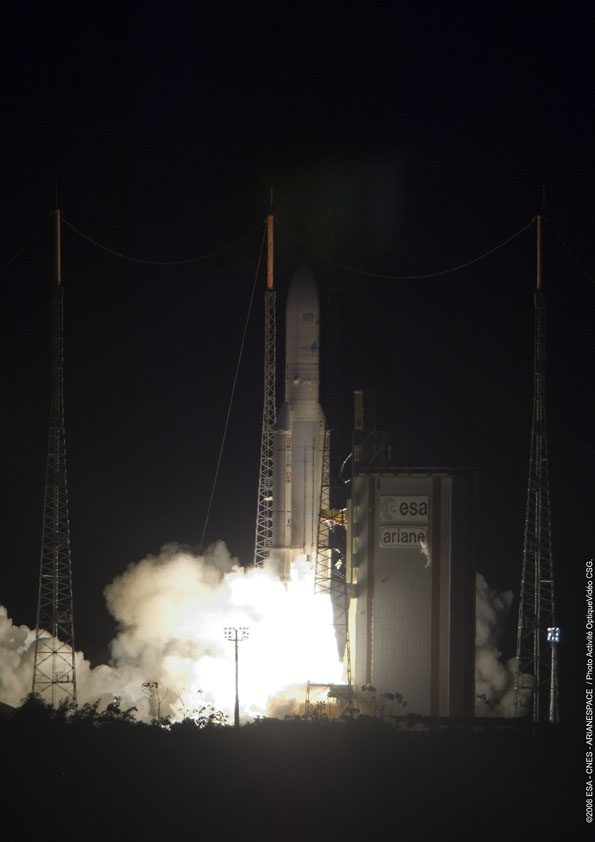 This
183rd Ariane mission is Ariane 5’s 39th launch and its 25th consecutive
commercial success. The launcher was carrying a total payload of 8,541
kg, including 7,745 kg for the two satellites This
183rd Ariane mission is Ariane 5’s 39th launch and its 25th consecutive
commercial success. The launcher was carrying a total payload of 8,541
kg, including 7,745 kg for the two satellites
Arianespace was
founded in 1980 as the world’s first launch service & solutions company.
Today, it has 23 shareholders from ten European countries (including French
space agency CNES with 34%, EADS with 30%, and all European companies participating
in the construction of Ariane launchers). Since the outset, the company
has signed 292 launch contracts and launched 257 satellites. More than
two-thirds of the commercial satellites now in service worldwide were launched
by Arianespace. Arianespace won over half of the commercial launch contracts
up for bid worldwide in the last two years, and has now a backlog
of more than 40 satellites to be launched. The company posted sales of
more than 900 million euros in 2007 and has 292 employees. |
| Source: |
Jonathan
Space Report No. 597
; Spacewarn No. 656
; National Space Science Data Center's
2007-0 ; Arianespace's 12
Jun 08 & Press
Kit ; SkyRocket's ; |
|
|
.
Turksat 3A
| Spacecraft: |
|
| Chronologies: |
2008 payload #48 ; 2008-030B ; 6,662nd spacecraft. |
| Type: |
Communications |
| Families: |
|
| Ranks: |
2,965th Civilian
spacecraft (6th Turk) ; 6th Turk (6th Civilian). |
| thSponsor: |
Turkey |
|
 |
| Launch: |
12 June 2008 at 22h05 UTC, from
Kourou Space Center's ELA-3, by an Ariane
5 ECA. |
| Orbit: |
Geostarionaty at 42° East longitude. |
| Mission: |
 Turksat
3A is a 3,110-kg (1,272 kg dry) communications satellite fitted with 24
Ku-band transponders that delivers communications services as well as broadcast
TV channels, multimedia and Internet services in Europe, Turkey and Central
Asia. The satellite was built by Thales Alenia Space for Turksat AS, as
part of a turnkey contract. The craft is a 3-axis stabilized Spacebus 4000
B2 platform measuring 2.8 x 1.8 x 2.9 metres (29.6 metres span in orbit)
with a 20-year lifespan. It is the fifth Turkish satellite launched by
Arianespace. Turksat
3A is a 3,110-kg (1,272 kg dry) communications satellite fitted with 24
Ku-band transponders that delivers communications services as well as broadcast
TV channels, multimedia and Internet services in Europe, Turkey and Central
Asia. The satellite was built by Thales Alenia Space for Turksat AS, as
part of a turnkey contract. The craft is a 3-axis stabilized Spacebus 4000
B2 platform measuring 2.8 x 1.8 x 2.9 metres (29.6 metres span in orbit)
with a 20-year lifespan. It is the fifth Turkish satellite launched by
Arianespace. |
| Source: |
Jonathan
Space Report No. 597
; Spacewarn No. 656
; National Space Science Data Center's
2007-0 ; Arianespace's 12
Jun 08 & Press
Kit ; SkyRocket's ; |
|
|
.
Orbcomm CDS-1
| Spacecraft: |
|
| Chronologies: |
2008 payload #49 ; 2008-031 ; 6,663rd spacecraft. |
| Type: |
Communications (Data Relay) |
| Families: |
|
| Ranks: |
|
| Sponsor: |
Orbcomm Inc. |
|
|
|
..
Orbcomm R-1
| Spacecraft: |
|
| Chronologies: |
2008 payload #50 ; 2008-031 ; 6,664th spacecraft. |
| Type: |
Communications (Data Relay) |
| Families: |
|
| Ranks: |
|
| Sponsor: |
Orbcomm Inc. |
|
|
|
.
Orbcomm R-2
| Spacecraft: |
|
| Chronologies: |
2008 payload #51 ; 2008-031 ; 6,665th spacecraft. |
| Type: |
Communications (Data Relay) |
| Families: |
|
| Ranks: |
|
| Sponsor: |
Orbcomm Inc. |
|
|
|
..
Orbcomm R-3
| Spacecraft: |
|
| Chronologies: |
2008 payload #52 ; 2008-031 ; 6,666th spacecraft. |
| Type: |
Communications (Data Relay) |
| Families: |
|
| Ranks: |
|
| Sponsor: |
Orbcomm Inc. |
|
|
|
..
Orbcomm R-4
| Spacecraft: |
|
| Chronologies: |
2008 payload #53 ; 2008-031 ; 6,667th spacecraft. |
| Type: |
Communications (Data Relay) |
| Families: |
|
| Ranks: |
|
| Sponsor: |
Orbcomm Inc. |
|
|
|
..
Orbcomm R-5
| Spacecraft: |
|
| Chronologies: |
2008 payload #54 ; 2008-031 ; 6,668th spacecraft. |
| Type: |
Communications (Data Relay) |
| Families: |
|
| Ranks: |
|
| Sponsor: |
Orbcomm Inc. |
|
|
|
.
OSTM/Jason 2
| Spacecraft: |
OSTM sands for Ocean Surface
Topography Mission (OSTM |
| Chronologies: |
2008 payload #55 ; 2008-032A ; 6,669th spacecraft. |
| Type: |
Earth/Space Science (Ocean Observations) |
| Families: |
|
| Ranks: |
|
| Sponsor: |
NASA, CNES, Eumetsat and NOAA |
|
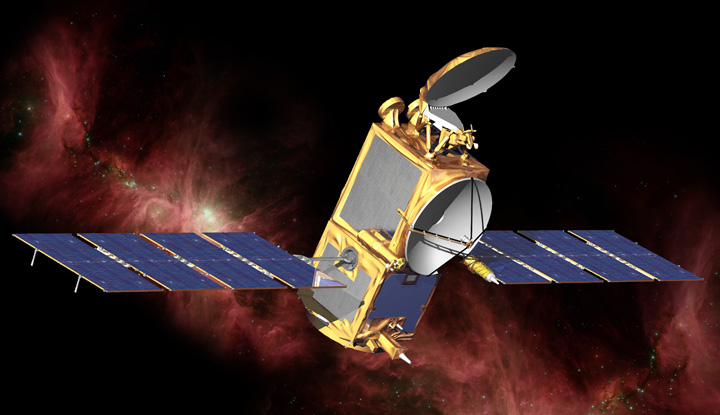
Source: NASA
|
Views of OSTM/Jason 2 satellite (Source:
NASA)
| Launch: |
20 June 2008 at 7h46 UTC, from
Vandenberg Air Force Base, by a Delta II
7320. |
| Orbit: |
Circular at 1336 km x 66° |
| Mission: |
OSTM/Jason 2 is the 510-kg next-generation
ocean altimetry satellite that extends the observations of sea surface
topography begun by Topex-Poseidon
and Jason 1. It carries the
next generation instruments including CNES’s Poseidon-3 dual-frequency
radar altimeter to measure sea surface height and NASA/JPL’s Advanced Microwave
Radiometer (AMR) to remove the effects of water vapor from the altimetry
measurement. Its precise measurement (3.3 centimeters) will help scientists
better understand ocean circulation and its effect on global climate. This
mission works in combination with several other missions, including the
Gravity
Recovery and Climate Experiment, which measures Earth’s mass distribution,
QuikScat,
which measures near-surface ocean winds, and Aquarius (to be launched in
2009) which measures ocean surface salinity. Three additional new instruments
are also onboard: Japan’s Light Particle Telescope (LPT) and France’s Environment
Characterization and Modelisation-2 (Carmen-2) to study radiation in the
satellite environment, and France’s Time Transfer by Laser Link (T2L2)
that used a laser link to make high-accuracy comparison and synchronization
of remote ground clocks. In addition to the basic scientific interest,
these instruments will allow for enhancements in data quality and accuracy
for future ocean altimetry missions. Jason 2 is a four-partner mission
with NASA, CNES, the European Organisation for the Exploitation of Meteorological
Satellites (Eumetsat), and NOAA. The spacecraft is operations by NOAA and
Eumetsat and its data are available to the international science community
via the U.S. (NOAA) and European data centers (EUMETSAT, CNES). |
| Source: |
Jonathan
Space Report No. 597
; Spacewarn No. 656
; National Space Science Data Center's
2007-0 NASA's OSTM/Jason
2 ; SkyRocket's ; NASA's 2010-2014
NASA News Releases ; |
|
|
.
Kosmos 2440
| Spacecraft: |
|
| Chronologies: |
2008 payload #56 ; 2008-033A ; 6,670th spacecraft. |
| Type: |
Missile Early Warning |
| Families: |
|
| Ranks: |
|
| Sponsor: |
Russian Defense Ministry |
|
|
|
.
ProtoStar I
| Spacecraft: |
|
| Chronologies: |
2008 payload #57 ; 2008-034A ; 6,671st spacecraft. |
| Type: |
Communications (Direct Broadcasting) |
| Families: |
|
| Ranks: |
|
| Sponsor: |
ProtoStar Ltd. |
|
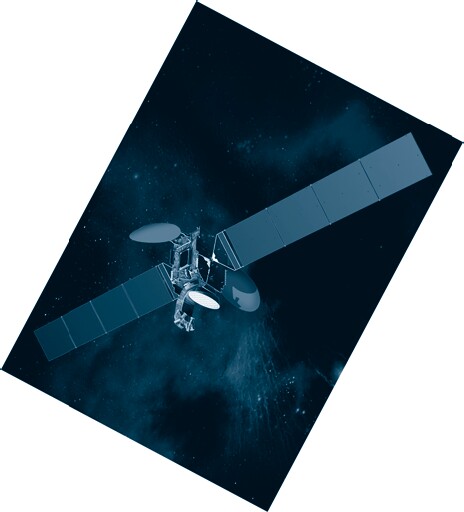 |
| Launch: |
7 July 2008 at 21h47 UTC, from
Kourou Space Center's ELA-3, by an Ariane
5 ECA. |
| Orbit: |
Geostationary at 98.5° East longitude. |
| Mission: |
ProtoStar 1 is a 4,200-kg (at launch, 1,774-kg
dry) communications satellite that provide relay capacity over Asia for
direct-to-home television broadcasting as well as broadband communication
requirements across the region. It is the first satellite for a new operator:
ProtoStar telecommunciations service provider. The craft is fitted with
16 Ku-band transponders and 38 C-band transponders. Built by Space Systems/Loral
using an FS1300 platform, ProtoStar I is 3-axis stabilized satellite measuring
3.8 x 2.4 x 2.1 metres (with an in-orbit span of 31.1 metres), and with
a 15-year designed lifespan. |
| Launch: |
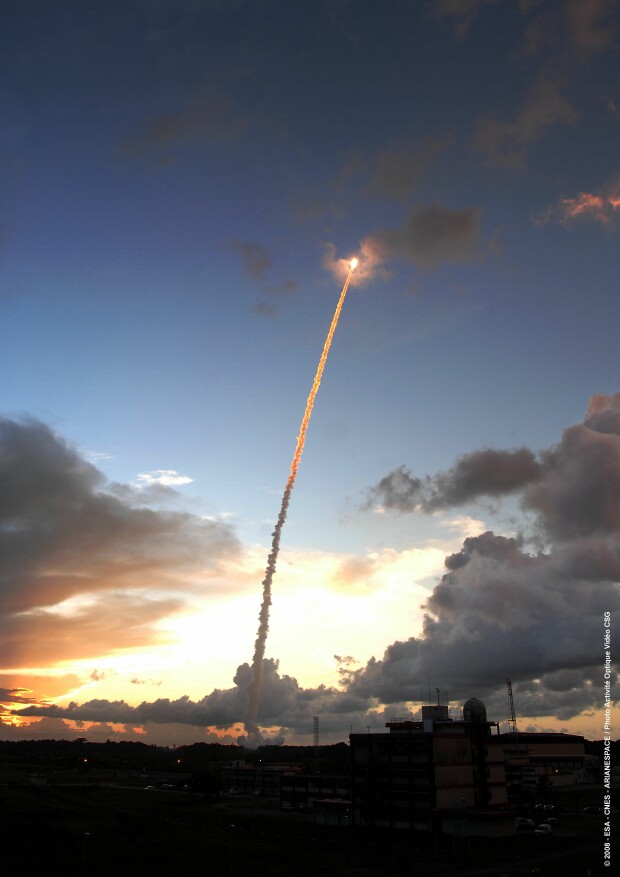 The
184th Ariane mission, the 40th Ariane 5 launch, was carrying a total payload
of 8,639 kg, including 7,537 kg for the two satellites. The countdown was
performed without interruption, leading to an on-time liftoff just prior
sunset, providing a rare daylight view of the launcher's ascent. The weather
allowed tracking cameras to follow the launcher’s trajectory for well over
two minutes, which included the separation of both solid boosters at an
altitude of approximately 65 km. The
184th Ariane mission, the 40th Ariane 5 launch, was carrying a total payload
of 8,639 kg, including 7,537 kg for the two satellites. The countdown was
performed without interruption, leading to an on-time liftoff just prior
sunset, providing a rare daylight view of the launcher's ascent. The weather
allowed tracking cameras to follow the launcher’s trajectory for well over
two minutes, which included the separation of both solid boosters at an
altitude of approximately 65 km. |
| Source: |
Jonathan
Space Report No. 598
; Spacewarn No. 657
; National Space Science Data Center's
2007-0 ; Arianespace's 7
Jul 08 & Press
Kit ; SkyRocket's ; |
|
|
.
Badr 6
| Spacecraft: |
|
| Chronologies: |
2008 payload #58 ; 2008-034B ; 6,672nd spacecraft. |
| Type: |
Communications (Direct Broadcasting) |
| Families: |
|
| Ranks: |
|
| Sponsor: |
Abarsat |
|
 |
| Launch: |
7 July 2008 at 21h47 UTC, from
Kourou Space Center's ELA-3, by an Ariane
5 ECA. |
| Orbit: |
Geostationary at 26° East longitude. |
| Mission: |
Badr-6 is a 3,400-kg (at launch, 1,510-kg
dry) direct-broadcast satellite, equipped with 24 C-band and 20 Ku-band
transponders that provides TV broadcasting services for the entire Middle
East and North Africa. Along with other satellites in the Badr constellation,
it provides services to more than 130 million TV viewers stretching from
Morocco to the Persian Gulf, and over a large part of sub-Saharan Africa.
Jointly built by EADS Astrium and Thales Alenia Space using an Eurostar
2000+ platform, Badr-6 is a 3-axis stabilized satellite measuring 2.9 x
1.75 x 2.5 metres (with an in-orbit span of 32 metres) and with a 15-year
life expectancy. |
| Source: |
Jonathan
Space Report No. 598
; Spacewarn No. 657
; National Space Science Data Center's
2007-0 ; Arianespace's 7
Jul 08 & Press
Kit ; SkyRocket's ; |
|
|
.
EchoStar XI
| Spacecraft: |
|
| Chronologies: |
2008 payload #59 ; 2008-035A ; 6,673rd spacecraft. |
| Type: |
Communications (Direct Broadcast) |
| Families: |
|
| Ranks: |
|
| Sponsor: |
DISH Network Corporation (EchoStar) |
|
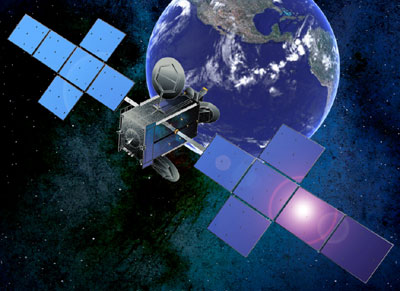
|
| Launch: |
16 July 2008 at 5h21 UTC, from
the Odyssey Launch Platform, by a Zenit-3SL.
(The Odyssey platform was positioned on the
Equator by 154° West Longitude.) |
| Orbit: |
Geostationary at 110° West Longitude. |
| Mission: |
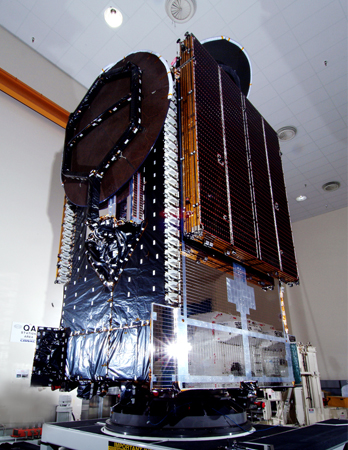 EchoStar
XI is a 5,511-kg, 20-kW direct broadcast satellite designed to expand capacity
for DISH Network Corporation (formerly EchoStar), which provides to 14
million satellite TV customers hundreds of video and audio channels and
interactive TV applications. Built by Space Systems/Lora, the satellite
is based on SS/L’s 1300 bus and is designed for an orbital service life
of 15 years. With this launch, there are 55 Space Systems/Loral -built
geostationary satellites in orbit. EchoStar
XI is a 5,511-kg, 20-kW direct broadcast satellite designed to expand capacity
for DISH Network Corporation (formerly EchoStar), which provides to 14
million satellite TV customers hundreds of video and audio channels and
interactive TV applications. Built by Space Systems/Lora, the satellite
is based on SS/L’s 1300 bus and is designed for an orbital service life
of 15 years. With this launch, there are 55 Space Systems/Loral -built
geostationary satellites in orbit. |
| Source: |
Jonathan
Space Report No. 598
; Spacewarn No. 657
; National Space Science Data Center's
2007-0 ; Sea Launch's
16
Jul 08 & EchoStar
XI ; SS/Loral's 28
May 08 & 16
Jul 08 ; SkyRocket's
; |
Launch of EchoStar XI by a Zenit rocket.
(Source: Sea
Launch)
|
|
.
SAR-Lupe 5
| Spacecraft: |
|
| Chronologies: |
2008 payload #60 ; 2008-036A ; 6,674th spacecraft. |
| Type: |
Radar Surveaillance |
| Families: |
|
| Ranks: |
|
| Sponsor: |
German Ministry of Defense and the Federal
Office of Defense Technology and Procurement |
|
|
|
.
Kosmos 2441
| Spacecraft: |
Persona No. 1 |
| Chronologies: |
2008 payload #61 ; 2008-037A ; 6,675th spacecraft. |
| Type: |
Surveillance |
| Families: |
|
| Ranks: |
|
| Sponsor: |
Russia Defense Ministry |
|
|
| Launch: |
26 July 2008 at 18h31 UTC, from
Plesetsk Cosmodrome's 34/4, by a Soyuz-2.1b. |
| Orbit: |
210 km x 770 km x 98.3° s 94 min. |
| Mission: |
The new optical reconnaissance satellite
Persona, designated Cosmos-2441, failed shortly after beginning its operations.
According to a report in Rossiyskaya Gazeta, the deputy prime minister,
Sergey Ivanov, criticized the industry for a string of satellite failures
- Monitor, KazSat, and Persona. The reports said that in the Persona case,
it was the electronics of the satellite that failed. It is hard to say
exactly when the satellite failure occurred. However, Cosmos-2441 has not
been performing any orbit-correction maneuvers since mid-September 2008. |
| Source: |
Jonathan
Space Report No. 598
; Spacewarn No. 657
; National Space Science Data Center's
2007-0 ; RSNF's 26
Jul 08 & 13
Feb 09 ; SkyRocket's
; |
|
|
.
Trailblazer
| Spacecraft: |
|
| Chronologies: |
2008 payload #62 ; 2008 1st loss ; 6,676th
spacecraft. |
| Type: |
Technology |
| Families: |
|
| Ranks: |
|
| Sponsor: |
U.S. Department of Defense |
|
|
| Launch: |
3 August 2008 at 3h34 UTC, from
Omelek Island, by a Falcon 1.
(Omelek Island, in the Kwajalein Atoll, is
located 4,000 kilometres southwest of Hawaii in the Central Pacific.) |
| Orbit: |
n/a |
| Mission: |
Trailblazer is a 83.5-kg experimental spacecraft
part of the Jumpstart Program of the Defense Department's Operationally
Responsive Space to demonstrate the rapid construction, testing and launch
of a low-cost satellite for the military. Developed by SpaceDev,
the craft aims to prove that small spacecraft can be built and put aboard
a rocket within a few months. This was the first mission of the Jumpstart
project, which also tests the flexibility of payload managers and launch
providers by simultaneously preparing three payloads for a single launch.
Engineers had to be prepared to support launching any of the spacecraft
reviewed by military leaders. Military officials evaluated three spacecraft
for the Jumpstart mission, eventually selecting the Trailblazer. The satellite
was constructed in less than five months, meeting schedule and budget criteria
set by the ORS program office. |
| Falcon 003 Payloads: |
The Falcon 1 also carried PreSat,
Nanosail-D
and Celestis' Explorers Flight as well as it tested
a payload adapter developed by Malaysian engineers. The adapter will connect
the rocket to the RazakSat 2 spacecraft from Malaysia on the Falcon 1's
next launch later this year. |
| Launch: |
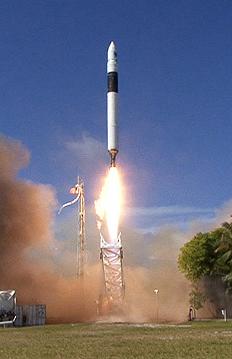 On
3 August, at 3h00 GMT - after four hours of delays - the Falcon 1’s main
engine fired but one of the propulsion parameters was about 1% out of range,
triggering the launch abort in the final moments before liftoff. The launch
team was able to resolve the issue quickly and the rocket lifted off 34
minutes later, at 15h34 local) time. An onboard camera appeared to
show some oscillations during the ascent. Whether that was normal or a
sign of trouble is not yet clear. About two minutes and 20 seconds into
the ascent, the video broadcast was abruptly terminated, the rocket was
still flying with no obvious indication of a serious malfunction
A company spokesperson then said: "We are hearing from the launch control
center that there has been an anomaly on the vehicle. We don't have any
information about what that anomaly is at this time. We will, of course,
be doing an assessment of the situation and providing information as soon
as it becomes available." In fact, the Falcon 1 reached an altitude
of 217 km when its first stage collided with the second stage due to residual
thrust from the upgraded Merlin engine, On
3 August, at 3h00 GMT - after four hours of delays - the Falcon 1’s main
engine fired but one of the propulsion parameters was about 1% out of range,
triggering the launch abort in the final moments before liftoff. The launch
team was able to resolve the issue quickly and the rocket lifted off 34
minutes later, at 15h34 local) time. An onboard camera appeared to
show some oscillations during the ascent. Whether that was normal or a
sign of trouble is not yet clear. About two minutes and 20 seconds into
the ascent, the video broadcast was abruptly terminated, the rocket was
still flying with no obvious indication of a serious malfunction
A company spokesperson then said: "We are hearing from the launch control
center that there has been an anomaly on the vehicle. We don't have any
information about what that anomaly is at this time. We will, of course,
be doing an assessment of the situation and providing information as soon
as it becomes available." In fact, the Falcon 1 reached an altitude
of 217 km when its first stage collided with the second stage due to residual
thrust from the upgraded Merlin engine,
“It was obviously
a big disappointment not to reach orbit on this flight, said SpaceX founder
Elon Musk. On the plus side, the flight of our first stage, with
the new Merlin 1C engine that will be used in Falcon 9, was picture perfect.
Unfortunately, a problem occurred with stage separation, causing the stages
to be held together. […] The most important message I’d like to send
right now is that SpaceX will not skip a beat in execution going forward.
We have flight four of Falcon 1 almost ready for flight and flight five
right behind that. I have also given the go ahead to begin fabrication
of flight six. Falcon 9 development will also continue unabated,
taking into account the lessons learned with Falcon 1. We have made
great progress this past week with the successful nine engine firing. There
should be absolutely zero question that SpaceX will prevail in reaching
orbit and demonstrating reliable space transport.” On 6 August 2008,
the company reported: “It looks like we may have flight four on the launch
pad as soon as next month.” |
| Source: |
Jonathan
Space Report No. 598
; National Space Science Data
Center's 2007-0 ; SpaceflightNow's 3
Augt 07, 6
Aug 08 & Mission
; SpaceX's Flight 3 ; SkyRocket's
; |
|
|
.
PreSat
| Spacecraft: |
|
| Chronologies: |
2008 payload #63 ; 2008 2nd loss ; 6,677th
spacecraft. |
| Type: |
Technology |
| Families: |
|
| Ranks: |
|
| Sponsor: |
NASA |
|
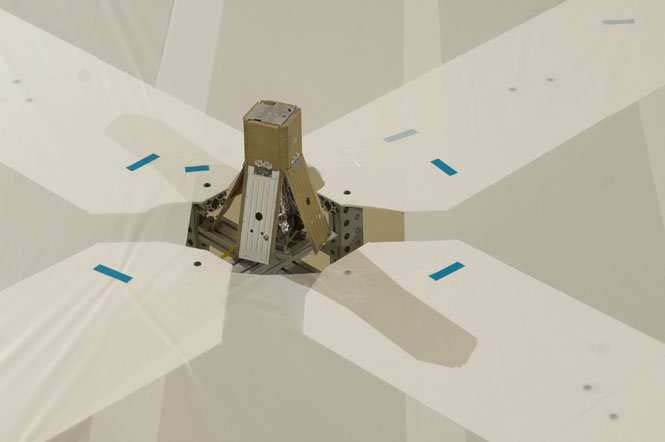
Source: NASA
|
| Launch: |
3 August 2008 at 3h34 UTC, from
Omelek Island, by a Falcon 1. |
| Orbit: |
n/a |
| Mission: |
PRESat, PharmaSat Risk Evaluation Satellite,
is a micro-laboratory equipped with sensors and optical systems that can
detect the growth, density and health of yeast cells. It was also monitor
the levels of pressure, temperature, and acceleration. PRESat would have
create a stable, space science laboratory using innovative environment
control and biological detection techniques. The PRESat-NanoSail-D nanosatellites
provides an opportunity to demonstrate NASA-developed spaceflight technologies
and the Ames-developed modular approach to constructing of satellites .
This mission provides NASA with a unique opportunity to evaluate how our
nanosatellite spacecraft and its payload perform, while demonstrating our
ability to conduct fast turn-around, low-cost spaceflight projects. This
same approach was used successfully on a previous mission, GeneSat, and
will be used for the upcoming PharmaSat mission, scheduled to launch later
this year. |
| Source: |
Jonathan
Space Report No. 598
; National Space Science Data Center's
2007-0 ; SkyRocket's ; |
|
|
.
Nanosail-D
| Spacecraft: |
|
| Chronologies: |
2008 payload #64 ; 2008 3rd loss ; 6,678th
spacecraft. |
| Type: |
Technology |
| Families: |
|
| Ranks: |
|
| Sponsor: |
NASA |
|

Source: NASA
|
| Launch: |
3 August 2008 at 3h34 UTC, from
Omelek Island, by a Falcon 1. |
| Orbit: |
n/a |
| Mission: |
NanoSail-D was to have unfurled, for the
first time in history, a 9-square metres solar sail, made of ultra-thin,
light gossamer fabric. With this sail, scientists had hoped to detect the
slight changes in NanoSail's orbit due to solar pressure and aerodynamic
drag a few days into the mission, proving the concept of propellant-less
space propulsion technologies using a solar sail. Packed inside the NanoSail-D
satellite the sail was made of ultra-thin, light gossamer fabric, coated
with a layer of aluminum to enhance its thrust-producing properties. The
reflective sails are designed to intercept the constantly streaming solar
energy and change the orbit of the spacecraft. Marshall Space Flight Center
provided materials for the NanoSail-D spacecraft and the solar sail payload,
including harvesting the sail material from an earlier solar sail propulsion
mission. The team also includes academic and industry partners who provided
economical commercial-off-the-shelf components that were quickly configured
and integrated to create the satellite. |
| Source: |
Jonathan
Space Report No. 598
; National Space Science Data Center's
2007-0 ; NASA's Nanosail-D&
Update
; SkyRocket's ; |
|
|
.
Celestis' Explorers
Flight
| Spacecraft: |
|
| Chronologies: |
2008 payload #65 ; 2008 4th loss ; 6,679th
spacecraft. |
| Type: |
|
| Families: |
|
| Ranks: |
|
| Sponsor: |
Space Services Inc. |
|
|
|
.
Superbird 7 / Superbird
C-2
| Spacecraft: |
|
| Chronologies: |
2008 payload #66 ; 2008-038A ; 6,680th spacecraft. |
| Type: |
Communications |
| Families: |
|
| Ranks: |
|
| Sponsor: |
Japan's Space Communications Corporation
(SCC) |
|
 |
| Launch: |
14 August 2008 at 20h44 UTC,
from Kourou Space Center's ELA-3, by an Ariane
5 ECA |
| Orbit: |
Geostarionaty at 144° East longitude |
| Mission: |
Superbird 7 is a 4,820-kg (2,018 kg dry)
communications satellite that carries 28 Ku-band transponders to provide
DTH, internet and television services to Japan, East-Asia, and the Pacific
region. Also known as Superbird C-2, it provides mobile terminal,
cable TV and direct TV broadcast services for the entire Asia-Pacific region.
Also known as Superbird C-2, the satelite replaces the aging Superbird-C.
Built by Mitsubishi Electric Corporation, Superbird-7 is based on a DS
2000 platform, it is a 3-axis stabilized craft, measuring 6.3 x 3.7 x 3.0
metres (which span 31.6 metres in orbit) and has a designed lifetime of
15-years. |
| Source: |
Jonathan
Space Report No. 599
; Spacewarn No. 658
; National Space Science Data Center's
2007-0 ; Arianespace's 14
Aug 08 & Press
Kit ; SCC's 15
Aug 08 ; SkyRocket's
; |
|
|
.
AMC 21 / Americom 21
| Spacecraft: |
|
| Chronologies: |
2008 payload #67 ; 2008-038B ; 6,681st spacecraft. |
| Type: |
Communications |
| Families: |
|
| Ranks: |
|
| Sponsor: |
SES Americom |
|
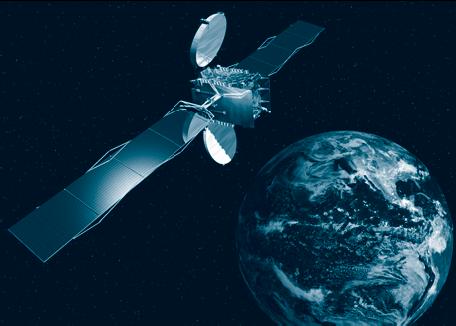 |
| Launch: |
14 August 2008 at 20h44 UTC,
from Kourou Space Center's ELA-3, by an Ariane
5 ECA |
| Orbit: |
Geostationary at 125° West longitude. |
| Mission: |
AMC 21, also known as Americom 21, is a 2,473-kg
(1,161 kg dry) communications satellite that carries 24 Ku-band transponders
and two reflector antennas to provide television services and broadband
connectivity to the United States, Canada, Mexico and Caribbean countries.
The satellite is operated by SES AMERICOM, the American operating company
of the Luxembourg-based SES group and is the 20th satellite from the SES
group. Built by Thales Alenia Space using a Star-2 platform from Orbital
Sciences Corporation, AMC-21 is 3-axis stabilized craft measuring 2.3 x
3.2 x 2.3 metres (with a 22-metre wingspan in orbit) and has a designed
lifespan of 15 years. |
| Source: |
Jonathan
Space Report No. 599
; Spacewarn No. 658
; National Space Science Data Center's
2007-0 ; Arianespace's 14
Aug 08 & Press
Kit ; SkyRocket's ; |
|
|
.
Iranian Test
| Spacecraft: |
|
| Chronologies: |
2008 payload n/a ; n/a ;n/a. |
| Type: |
Technology |
| Families: |
|
| Ranks: |
|
| Sponsor: |
Iran |
|
|
| Launch: |
16 August 2008 at 19h32 UTC,
from Semnan, by a Safir. |
| Orbit: |
n/a |
| Mission: |
 On
17 August, the Iranian’s Fars news agency reported the launch of the Omid
('Hope') satellite. However, other reports indicate that this was either
a suborbital test or a launch of a dummy satellite, and that the Omid satellite
was not aboard. According to some sources, the second stage failed catastrophically
at 152 km. Thus, that launch could eighter be a suborbital test launch
of a prototype satellite launch vehicle, or a failed orbital attempt, since
no satellite reached orbit. On
17 August, the Iranian’s Fars news agency reported the launch of the Omid
('Hope') satellite. However, other reports indicate that this was either
a suborbital test or a launch of a dummy satellite, and that the Omid satellite
was not aboard. According to some sources, the second stage failed catastrophically
at 152 km. Thus, that launch could eighter be a suborbital test launch
of a prototype satellite launch vehicle, or a failed orbital attempt, since
no satellite reached orbit. |
| Source: |
Jonathan
Space Report No. 599
; BBC 17 Aug
08, & 16
Aug 08 ; Xinhua 16
Aug 08 , Reuter 19
Aug 08 ; New York Times, 17
Aug 08 ; MSNBC 19
Aug 08 , |
|
|
.
Inmarsat 4 F3
| Spacecraft: |
|
| Chronologies: |
2008 payload #68 ; 2008-039A ; 6,682nd spacecraft. |
| Type: |
Communications |
| Families: |
|
| Ranks: |
|
| Sponsor: |
Inmarsat |
|
 |
| Launch: |
18 August 2008 at 22h43 UTC,
from Baykonur Cosmodrome's LC-200/39, by a Proton-M/Briz-M. |
| Orbit: |
Geostationary at 98° West longitude |
| Mission: |
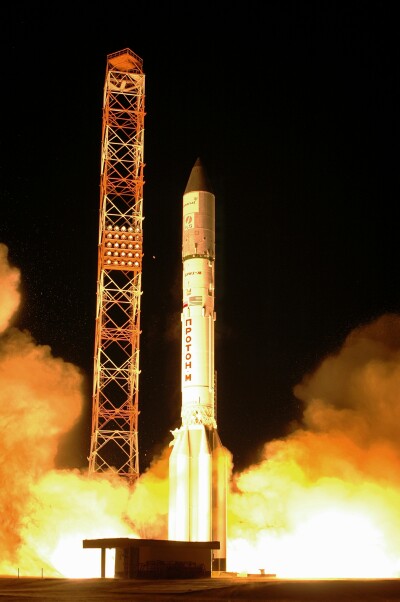 Inmarsat
4F3 is a 5,960-kg communications satellite that carries 200 spot-beams
to relay messages from mobile phones based on land, sea and air.
The satellite is the third in the Inmarsat’s I-4 constellation, concluding
a decade of development and a US$1.5 billion investment. The satellite
is a Eurostar 3000GM model built by EADS Astrium. The current constellation
of two Inmarsat-4 satellites delivers mobile broadband services to 85%
of the world's landmass, covering 98% of the world's population. The third
I-4 will complete the global coverage for Inmarsat's broadband services.
According to the company, the Inmarsat-4s are the world's most sophisticated
commercial network for mobile voice and data services. Inmarsat satellites
are used by shipping, oil exploration, defence and aviation industries
to service their communications needs. Inmarsat is also the communications
channel of choice for the media when reporting from the world's danger
zones and for NGOs, government agencies and the United Nations when coordinating
rescue efforts. Inmarsat
4F3 is a 5,960-kg communications satellite that carries 200 spot-beams
to relay messages from mobile phones based on land, sea and air.
The satellite is the third in the Inmarsat’s I-4 constellation, concluding
a decade of development and a US$1.5 billion investment. The satellite
is a Eurostar 3000GM model built by EADS Astrium. The current constellation
of two Inmarsat-4 satellites delivers mobile broadband services to 85%
of the world's landmass, covering 98% of the world's population. The third
I-4 will complete the global coverage for Inmarsat's broadband services.
According to the company, the Inmarsat-4s are the world's most sophisticated
commercial network for mobile voice and data services. Inmarsat satellites
are used by shipping, oil exploration, defence and aviation industries
to service their communications needs. Inmarsat is also the communications
channel of choice for the media when reporting from the world's danger
zones and for NGOs, government agencies and the United Nations when coordinating
rescue efforts. |
| Source: |
Jonathan
Space Report No. 599
; Spacewarn No. 658
; National Space Science Data Center's
2007-0 ; Spaceflight Now's 19
Aug 08 ; Inmarsat's 18
Aug 08 ; ILS's 18 Aug
08 ; SkyRocket's
; |
|
|
.
Tachys
| Spacecraft: |
Tachys is the Greek word meaning
rapid. |
| Chronologies: |
2008 payload #69 ; 2008-040A ; 6,683rd spacecraft. |
| Type: |
Earth Imaging |
| Families: |
|
| Ranks: |
|
| Sponsor: |
RapidEye AG |
|
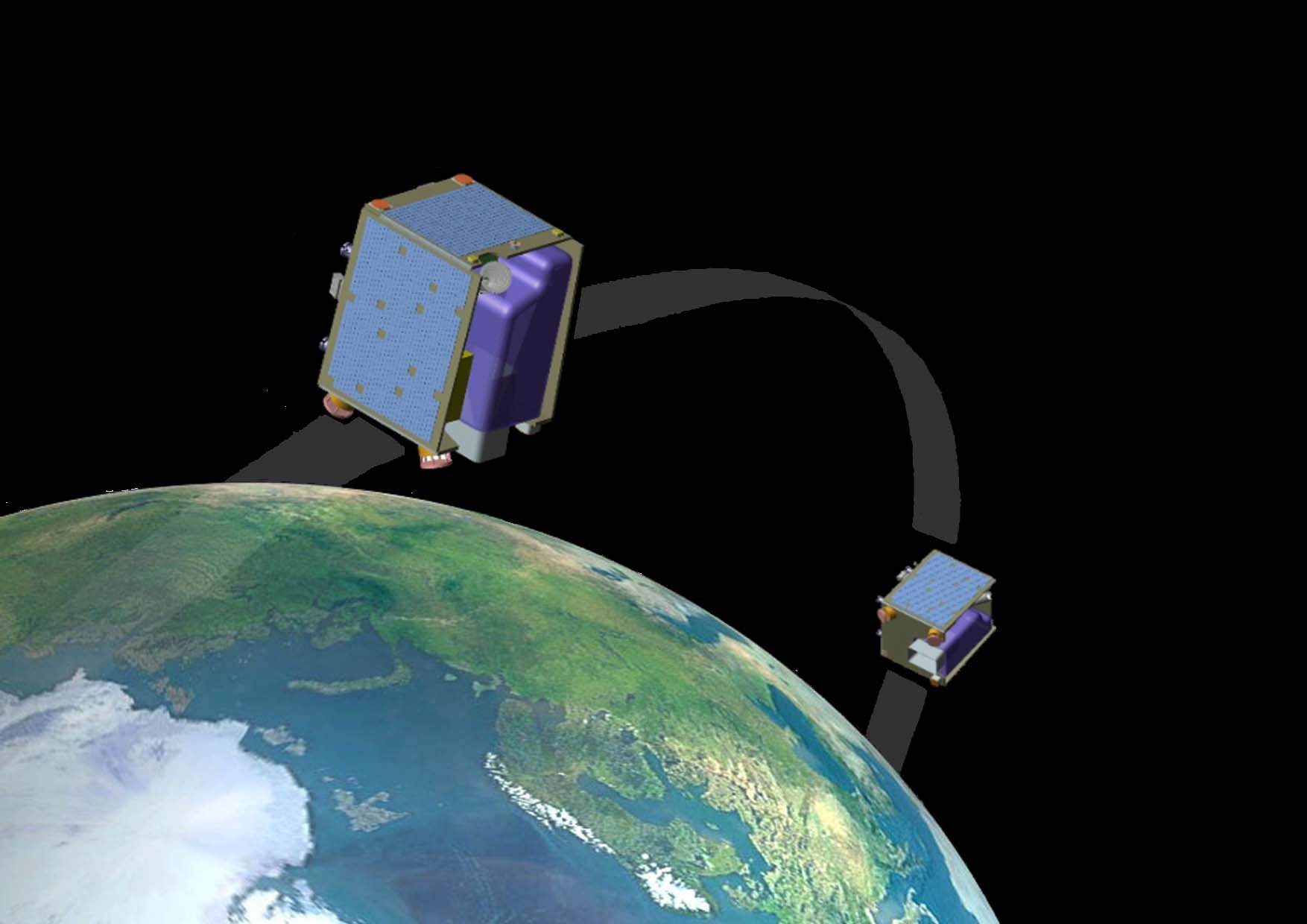 |
| Launch: |
29 August 2008 at 7h16 UTC, from
Baykonur Cosmodrome's LC-109, by a Dnepr. |
| Orbit: |
Initial: 585 km x 609 km x 98.0° x 97
min. |
| Mission: |
Five identical 150-kg Earth imaging satellites
that take multi-spectral, 6.5-metre resolution images to be sold to agricultural,
forestry and town-planning enterprises. RapidEye's primary applications
include monitoring crops and giving farmers, insurance companies and disaster
relief organizations critical information following a natural catastrophe.
The fleet will be able to cover any place on Earth within one day and image
all agricultural regions of Europe and North America within five days.
The constellation, which had a planned 7 year lifespan, differentiated
for other Earth-imaging system by rapid response and timely products. Each
satellite have an orbital spacing of about 19 minutes, allowing frequent
revisits over the same area. |
| Source: |
Jonathan
Space Report No. 599
; Spacewarn No. 658
; National Space Science Data Center's
2007-0 ; SpaceflightNow's 29
Aug 08 ; RapidEye's 29
Aug 08 & News
; SkyRocket's ; |
|
|
.
Mati
| Spacecraft: |
Mati is the Greek word meaning
eye. |
| Chronologies: |
2008 payload #70 ; 2008-040B ; 6,684th spacecraft. |
| Type: |
Earth Imaging |
| Families: |
|
| Ranks: |
|
| Sponsor: |
RapidEye AG |
|
 |
| Launch: |
29 August 2008 at 7h16 UTC, from
Baykonur Cosmodrome's LC-109, by a Dnepr. |
| Orbit: |
Initial: 585 km x 609 km x 98.0° x 97
min. |
| Mission: |
Five identical 150-kg Earth imaging satellites
that take multi-spectral, 6.5-metre resolution images to be sold to agricultural,
forestry and town-planning enterprises. RapidEye's primary applications
include monitoring crops and giving farmers, insurance companies and disaster
relief organizations critical information following a natural catastrophe.
The fleet will be able to cover any place on Earth within one day and image
all agricultural regions of Europe and North America within five days.
The constellation, which had a planned 7 year lifespan, differentiated
for other Earth-imaging system by rapid response and timely products. Each
satellite have an orbital spacing of about 19 minutes, allowing frequent
revisits over the same area. |
| Source: |
Jonathan
Space Report No. 599
; Spacewarn No. 658
; National Space Science Data Center's
2007-0 ; SpaceflightNow's 29
Aug 08 ; RapidEye's 29
Aug 08 & News
; SkyRocket's ; |
|
|
.
Choma
| Spacecraft: |
Choma is the Greek word meaning
Earth |
| Chronologies: |
2008 payload #71 ; 2008-040C ; 6,685th spacecraft. |
| Type: |
Earth Imaging |
| Families: |
|
| Ranks: |
|
| Sponsor: |
RapidEye AG |
|
 |
| Launch: |
29 August 2008 at 7h16 UTC, from
Baykonur Cosmodrome's LC-109, by a Dnepr. |
| Orbit: |
Initial: 585 km x 609 km x 98.0° x 97
min. |
| Mission: |
Five identical 150-kg Earth imaging satellites
that take multi-spectral, 6.5-metre resolution images to be sold to agricultural,
forestry and town-planning enterprises. RapidEye's primary applications
include monitoring crops and giving farmers, insurance companies and disaster
relief organizations critical information following a natural catastrophe.
The fleet will be able to cover any place on Earth within one day and image
all agricultural regions of Europe and North America within five days.
The constellation, which had a planned 7 year lifespan, differentiated
for other Earth-imaging system by rapid response and timely products. Each
satellite have an orbital spacing of about 19 minutes, allowing frequent
revisits over the same area. |
| Source: |
Jonathan
Space Report No. 599
; Spacewarn No. 658
; National Space Science Data Center's
2007-0 ; SpaceflightNow's 29
Aug 08 ; RapidEye's 29
Aug 08 & News
; SkyRocket's ; |
|
|
.
Choros
| Spacecraft: |
Choros is the Greek word meaning
space. |
| Chronologies: |
2008 payload #72 ; 2008-040D ; 6,686th spacecraft. |
| Type: |
Earth Imaging |
| Families: |
|
| Ranks: |
|
| Sponsor: |
RapidEye AG |
|
 |
| Launch: |
29 August 2008 at 7h16 UTC, from
Baykonur Cosmodrome's LC-109, by a Dnepr. |
| Orbit: |
Initial: 585 km x 609 km x 98.0° x 97
min. |
| Mission: |
Five identical 150-kg Earth imaging satellites
that take multi-spectral, 6.5-metre resolution images to be sold to agricultural,
forestry and town-planning enterprises. RapidEye's primary applications
include monitoring crops and giving farmers, insurance companies and disaster
relief organizations critical information following a natural catastrophe.
The fleet will be able to cover any place on Earth within one day and image
all agricultural regions of Europe and North America within five days.
The constellation, which had a planned 7 year lifespan, differentiated
for other Earth-imaging system by rapid response and timely products. Each
satellite have an orbital spacing of about 19 minutes, allowing frequent
revisits over the same area. |
| Source: |
Jonathan
Space Report No. 599
; Spacewarn No. 658
; National Space Science Data Center's
2007-0 ; SpaceflightNow's 29
Aug 08 ; RapidEye's 29
Aug 08 & News
; SkyRocket's ; |
|
|
.
Trochia
| Spacecraft: |
Trochia is the Greek word meaning
orbit. |
| Chronologies: |
2008 payload #73 ; 2008-040E ; 6,687th spacecraft. |
| Type: |
Earth Imaging |
| Families: |
|
| Ranks: |
|
| Sponsor: |
RapidEye AG |
|
 |
| Launch: |
29 August 2008 at 7h16 UTC, from
Baykonur Cosmodrome's LC-109, by a Dnepr. |
| Orbit: |
Initial: 585 km x 609 km x 98.0° x 97
min. |
| Mission: |
Five identical 150-kg Earth imaging satellites
that take multi-spectral, 6.5-metre resolution images to be sold to agricultural,
forestry and town-planning enterprises. RapidEye's primary applications
include monitoring crops and giving farmers, insurance companies and disaster
relief organizations critical information following a natural catastrophe.
The fleet will be able to cover any place on Earth within one day and image
all agricultural regions of Europe and North America within five days.
The constellation, which had a planned 7 year lifespan, differentiated
for other Earth-imaging system by rapid response and timely products. Each
satellite have an orbital spacing of about 19 minutes, allowing frequent
revisits over the same area. |
| Source: |
Jonathan
Space Report No. 599
; Spacewarn No. 658
; National Space Science Data Center's
2007-0 ; SpaceflightNow's 29
Aug 08 ; RapidEye's 29
Aug 08 & News
; SkyRocket's ; |
|
|
.
HJ-1A / Huan Jing-1A
| Spacecraft: |
|
| Chronologies: |
2008 payload #74 ; 2008-041A ; 6,688th spacecraft. |
| Type: |
Earth Remote Sensing |
| Families: |
|
| Ranks: |
|
| Sponsor: |
China |
|
|
| Launch: |
6 September 2008 at 3h25 UTC,
from Taiyuan Satellite Launch Center, by a Chang
Zheng 2C. |
| Orbit: |
627 km x 670 km x 98.01°x 97.6 min. |
| Mission: |
  Huan
Jing 1A and Huan Jing 1B are two environmental satellites that carry optical
and infrared cameras to monitor natural disasters like earthquakes and
floods. They closely track natural disasters and provide quick assessments
of damage to guide rescue and reconstruction work. First of their kind
for China, they were expected to enhance China’s capacity to forecast natural
disasters during their expected ifespan of more than three years. Huan
Jing 1A and Huan Jing 1B are two environmental satellites that carry optical
and infrared cameras to monitor natural disasters like earthquakes and
floods. They closely track natural disasters and provide quick assessments
of damage to guide rescue and reconstruction work. First of their kind
for China, they were expected to enhance China’s capacity to forecast natural
disasters during their expected ifespan of more than three years. |
| Source: |
Jonathan
Space Report No. 600
; Spacewarn No. 659
; National Space Science Data Center's
2007-0 ; China Daily's 6
Sep 08 ; SkyRocket's
; |
|
|
.
HJ-1B / Huan Jing-1B
| Spacecraft: |
|
| Chronologies: |
2008 payload #75 ; 2008-041B ; 6,689th spacecraft. |
| Type: |
Earth Remote Sensing |
| Families: |
|
| Ranks: |
|
| Sponsor: |
China |
|
|
| Launch: |
6 September 2008 at 3h25 UTC,
from Taiyuan Satellite Launch Center, by a Chang
Zheng 2C. |
| Orbit: |
627 km x 670 km x 98.01°x 97.6 min. |
| Mission: |
Huan Jing 1A and Huan Jing 1B are two environmental
satellites that carry optical and infrared cameras to monitor natural disasters
like earthquakes and floods. They closely track natural disasters and provide
quick assessments of damage to guide rescue and reconstruction work. First
of their kind for China, they were expected to enhance China’s capacity
to forecast natural disasters during their expected ifespan of more than
three years. |
| Source: |
Jonathan
Space Report No. 600
; Spacewarn No. 659
; National Space Science Data Center's
2007-0 ; China Daily's 6
Sep 08 ; SkyRocket's
; |
|
|
.
GeoEye 1
| Spacecraft: |
|
| Chronologies: |
2008 payload #76 ; 2008-042A ; 6,690th spacecraft. |
| Type: |
Earth Remote Sensing |
| Families: |
|
| Ranks: |
|
| Sponsor: |
US National Geo-spatial Intelligence Agency
(NGA) |
|
 |
|
.
Progress M-65 / ISS
30P
| Spacecraft: |
Progress M (7K-TGM) No. 365 |
| Chronologies: |
2008 payload #77 ; 2008-043A ; 6,691st spacecraft. |
| Type: |
Cargo delivery to the International Space
Station |
| Families: |
|
| Ranks: |
|
| Sponsor: |
Russian Space Agency |
|
|
|
.
Nimiq 4
| Spacecraft: |
|
| Chronologies: |
2008 payload #78 ; 2008-044A ; 6,692nd spacecraft. |
| Type: |
Communications |
| Families: |
|
| Ranks: |
|
| Sponsor: |
Telesat Canada |
|
|
| Launch: |
24 September 2008 at 19h28 UTC,
from Odyssey Launch Platform, by a Proton-M/Briz-M.. |
| Orbit: |
Geostationary at 82° West longitude. |
| Mission: |
Nimiq 4 is a 4,850-kg communications satellite
equipped with 32 transponders in Ku-band and 8 in Ka-band. The comsat is
fully leased to Bell TV to enable the company to expand its HDTV digital
satellite television services over North America. The spacecraft has a
solar array wing span of 39 meters and an expected 15-year mission life.
Nimiq 4 was built by EADS Astrium. |
| Source: |
Jonathan
Space Report No. 600
; Spacewarn No. 659
; National Space Science Data Center's
2007-0 ; Telesat's 20
Sep 08 ; SkyRocket's
; |
|
|
.
Galaxy 19
| Spacecraft: |
|
| Chronologies: |
2008 payload #79 ; 2008-045A ; 6,793rd spacecraft. |
| Type: |
Communications |
| Families: |
|
| Ranks: |
|
| Sponsor: |
Intelsat |
|
|
| Launch: |
24 September 2008 at 9h28 UTC,
from Odyssey Launch Platform, by a Zenit-3SL. |
| Orbit: |
Geostationary at 97º West longitude. |
| Mission: |
Galaxy 19 is a communications satellite that
covered the United Statei, Caribbean, Canada and Mexico, for video, government
and network customers. It joins Intelsat’s North American Galaxy fleet
comprising 16 other satellites. Built by Space Systems/Loral, Galaxy 19
replaced Galaxy 25. spacecraft. |
| Source: |
Jonathan
Space Report No. 600
; Spacewarn No. 659
; National Space Science Data Center's
2007-0 ; Intelsat's 24
Sep 08 & Fact
Sheet ; SkyRocket's ; |
|
|
.
Kosmos 2442
| Spacecraft: |
Glonass No. 724 |
| Chronologies: |
2008 payload #80 ; 2008-046A ; 6,694th spacecraft. |
| Type: |
Navigation |
| Families: |
|
| Ranks: |
|
| Sponsor: |
Russian Defense Ministry |
|
|
|
.
Kosmos 2443
| Spacecraft: |
Glonass No. 725 |
| Chronologies: |
2008 payload #81 ; 2008-046C ; 6,695th spacecraft. |
| Type: |
Navigation |
| Families: |
|
| Ranks: |
|
| Sponsor: |
Russian Defense Ministry |
|
|
|
.
Kosmos 2444
| Spacecraft: |
Glonass No. 726 |
| Chronologies: |
2008 payload #82 ; 2008-046B ; 6,696th spacecraft. |
| Type: |
Navigation |
| Families: |
|
| Ranks: |
|
| Sponsor: |
Russian Defense Ministry |
|
|
|
.
Shenzhou VII
| Spacecraft: |
|
| Chronologies: |
2008 payload #83 ; 2008-047A ; 6,697th spacecraft. |
| Type: |
Piloted Spaceflight |
| Families: |
|
| Ranks: |
|
| Sponsor: |
China |
|
 |
|
.
BX-1
| Spacecraft: |
|
| Chronologies: |
2008 payload #84 ; 2008-047G ; 6,698th spacecraft. |
| Type: |
Technology |
| Families: |
|
| Ranks: |
|
| Sponsor: |
China |
|
|
|
..
Ratsat
| Spacecraft: |
|
| Chronologies: |
2008 payload #85 ; 2008-048A ; 6,699th spacecraft. |
| Type: |
Technology (Launcher Test) |
| Families: |
|
| Ranks: |
|
| Sponsor: |
SpaceX |
|
|
|
.
THEOS
| Spacecraft: |
|
| Chronologies: |
2008 payload #86 ; 2008-049A ; 6,700th spacecraft. |
| Type: |
Earth Remote Sensing |
| Families: |
|
| Ranks: |
|
| Sponsor: |
Thailand |
|
|
|
.
Soyuz TMA-13 / ISS 17S
| Spacecraft: |
Soyuz 11F732 (7K-STMA) No. 223 |
| Chronologies: |
2008 payload #87 ; 2008-050A ; 6,701st spacecraft. |
| Type: |
Piloted Spaceship |
| Families: |
|
| Ranks: |
|
| Sponsor: |
Russian Space Agency |
|

Source: NASA
|
| Launch: |
12 October 2008 at 7h01 UTC,
from Baykonur Cosmodrome's LC-1, by a Soyuz-FG |
| Orbit: |
Initial: 200.7 km x 259.89 km x 51.65°
z 88.81 min
At docking: 351.2 km x 368.4 km x 51.65°
91.5 min |
| Landing: |
8 April 2009 àt 7h16 UTC at 151 km
northeast of Dzezhkazgan. |
| Mission: |
Soyuz TMA-13 is a piloted transport ship
that delivered to the International Space Station the Expedition 18 crew
(ISS-18) of Commander Michael Fincke and Flight Engineer Yury Lonchakov,
as well as the space flight participant Richard Garriotte under the program
of the Visiting Mission 15. Fincke is the first American to launch
twice on a Soyuz.. The six-month Expedition 18 mission's main focus will
be preparing the station to house six crew members on long-duration missions.
Garriott is the son of former astronaut Owen Garriott. He and Expedition
17 Commander Sergey Volkov are the first children of previous space fliers
to greet each other in orbit, since Volkov is the son of veteran cosmonaut
Alexander Volkov. After two days of free flight, Soyuz TMA-13 docked in
automatic mode with ISS on 14 October at 8h26 UTC. |
| Source: |
Jonathan
Space Report No. 601
& 610
; Spacewarn No.
; National Space Science Data Center's
2007-0 ; SpsceflightNow's 12
Oct 08 & 14
Oct 08 ; NASA's ; SkyRocket's
; |
|
|
.
IBEX
| Spacecraft: |
Interstellar Boundary Explorer |
| Chronologies: |
2008 payload #88 ; 2008-051A ; 6,702nd spacecraft. |
| Type: |
Space Science |
| Families: |
|
| Ranks: |
|
| Sponsor: |
NASA |
|
 |
|
.
Chandraayan-1
| Spacecraft: |
Chandrayaan means "moon craft"
in Sanskrit. |
| Chronologies: |
2008 payload #89 ; 2008-052A ; 6,703rd spacecraft. |
| Type: |
Planetary Probe |
| Families: |
|
| Ranks: |
|
| Sponsor: |
Indian Space Research Organisation (ISRO) |
|
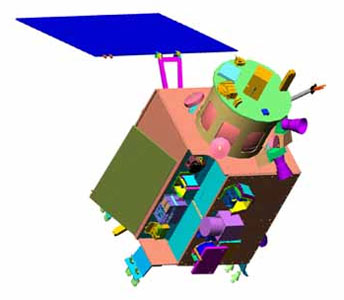 |
| Launch: |
22 October 2008 at 0h52 UTC,
from Sriharikota's Satish Dhawan Space Centre SHAR's SL-2, by a PSLV. |
| Orbit: |
Initial Earth orbit: 255 km x 22,860 km x
17.9° |
| Mission: |
 Chandrayaan-1
is a 1,380-kg lunar probe to perform remote sensing, mineralogical and
chemical mapping for about two years using eleven scientific instruments
built in India and five other countries. Thi mission will create
the most detailed global chemical map of the Moon showing mineral concentrations
across the lunar surface. Researchers will also make a three-dimensional
terrain map of the moon based on information yielded by the mission. Chandrayaan-1is
India’s first deep-space mission, as the European Space Agency fund three
payloads, while NASA provided two as Bulgarian scientists contributed a
radiation monitor to the mission. The spacecraft weighed about
1 380 kg at the time of its launch and is a 1.5-metre cuboid with a solar
panel projecting from one of its sides. It was built at ISRO Satellite
Centre, Bangalore. Chandrayaan-1
is a 1,380-kg lunar probe to perform remote sensing, mineralogical and
chemical mapping for about two years using eleven scientific instruments
built in India and five other countries. Thi mission will create
the most detailed global chemical map of the Moon showing mineral concentrations
across the lunar surface. Researchers will also make a three-dimensional
terrain map of the moon based on information yielded by the mission. Chandrayaan-1is
India’s first deep-space mission, as the European Space Agency fund three
payloads, while NASA provided two as Bulgarian scientists contributed a
radiation monitor to the mission. The spacecraft weighed about
1 380 kg at the time of its launch and is a 1.5-metre cuboid with a solar
panel projecting from one of its sides. It was built at ISRO Satellite
Centre, Bangalore. |
| Source: |
Jonathan
Space Report No. ; Spacewarn
No. ; National Space Science
Data Center's 2007-0 ; ISRO's
22
Oct 08,
23
Oct 08 ; SpsceflightNow's
22
Oct 08 ; ESA's 22
Oct 08 ; NASA’s 1
Mar 10 ; SkyRocket's
; |
|
|
..
MIP / Moon Impactor
Probe
| Spacecraft: |
|
| Chronologies: |
2008 payload #90 ; 2008 n/a ; 6,704th spacecraft. |
| Type: |
Planetary Probe |
| Families: |
|
| Ranks: |
|
| Sponsor: |
Indian Space Research Organisation (ISRO) |
|
|
| Launch: |
22 October 2008 at 0h52 UTC,
from Sriharikota's Satish Dhawan Space Centre SHAR's SL-2, by a PSLV. |
| Orbit: |
|
| Mission: |
The Moon Impact Probe (MIP) demonstrates
the technologies required for landing a probe at the desired location on
the Moon. It is also intended to qualify some of the technologies related
to future soft landing missions. After Chandrayaan-1 will be finally lowered
to its intended 100 km lunar orbit, the Moon Impact Probe will be ejected
to hit the lunar surface in a chosen area. |
| Source: |
Jonathan
Space Report No. ; Spacewarn
No. ; National Space Science
Data Center's 2007-0 ; ISRO's
Chandrayaan-1,
22
Oct 08 ; SpsceflightNow's
22
Oct 08 ; SkyRocket's
; |
|
|
.
COSMO-Skymed 3 / COSMO-3
| Spacecraft: |
|
| Chronologies: |
2008 payload #91 ; 2008-053A ; 6,705th spacecraft. |
| Type: |
Radar Surveillance |
| Families: |
|
| Ranks: |
|
| Sponsor: |
Italian Space Agency and Italian Ministry
of Defence |
|
|
|
.
SJ-6A-3 / Shi Jian 6A-3
| Spacecraft: |
|
| Chronologies: |
2008 payload #92 ; 2008-054A ; 6,706h spacecraft. |
| Type: |
Probably Electronic Intelligence |
| Families: |
|
| Ranks: |
|
| Sponsor: |
China |
|
|
| Launch: |
25 October 2008 at 1h15 UTC,
from Taiyuan Satellite Launch Center, by a Chang
Zheng 4B. |
| Orbit: |
580 km x 604 km x 97.7° |
| Mission: |
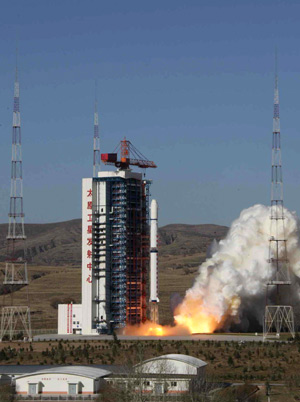 China
news agency reports that this third pair of Shi Jian 6 satellites were
performing environmental research. But lack of any details raises the suspicion
that they are military surveillance satellites of some kind. It is
thus supposed that, under cover of the Shijian scientific research series,
this SJ-6 pairs (as well as previous ones launched in 2004 and 2006) have
a military electronic intelligence mission. It is reported that the satellites
are built by the SAST group in Shanghai and the DFH Co. in Beijing, suggesting
that in each pair the two satellites are of different design. The DFH Co.
satellite is probably a CAST-968 300 kg-class minisatellite, and the SAST
satellite might be based on the larger FY-1 weather satellite bus. China
news agency reports that this third pair of Shi Jian 6 satellites were
performing environmental research. But lack of any details raises the suspicion
that they are military surveillance satellites of some kind. It is
thus supposed that, under cover of the Shijian scientific research series,
this SJ-6 pairs (as well as previous ones launched in 2004 and 2006) have
a military electronic intelligence mission. It is reported that the satellites
are built by the SAST group in Shanghai and the DFH Co. in Beijing, suggesting
that in each pair the two satellites are of different design. The DFH Co.
satellite is probably a CAST-968 300 kg-class minisatellite, and the SAST
satellite might be based on the larger FY-1 weather satellite bus.
Note: under the title “China
successfully launches research satellites“”, China Dayli only published
a photo of the of the launch with a simple caption that reads: “A Long
March-4B rocket carrying two Shijian-6 research satellites for space environment
investigation blasts off. from the launch pad at the Taiyuan Satellite
Launch Center, north China's Shanxi Province, on Oct. 25, 2008.” |
| Source: |
Jonathan
Space Report No. 602
; Spacewarn No.
; National Space Science Data Center's
2007-0 ; China Daily's 25
Oct 08 ; Astronautica Encyclopedia's SJ-6
; SkyRocket's ; |
|
|
.
SJ-6B-3 / Shi Jian 6B-3
| Spacecraft: |
|
| Chronologies: |
2008 payload #93 ; 2008-054B ; 6,707th spacecraft. |
| Type: |
Probably Electronic Intelligence |
| Families: |
|
| Ranks: |
|
| Sponsor: |
China |
|
|
| Launch: |
26 October 2008 at 1h15 UTC,
from Taiyuan Satellite Launch Center, by a Chang
Zheng 4B. |
| Orbit: |
580 km x 604 km x 97.7° |
| Mission: |
China news agency reports that this third
pair of Shi Jian 6 satellites were performing environmental research. But
lack of any details raises the suspicion that they are military surveillance
satellites of some kind. It is thus supposed that, under cover of
the Shijian scientific research series, this SJ-6 pairs (as well as previous
ones launched in 2004 and 2006) have a military electronic intelligence
mission. It is reported that the satellites are built by the SAST group
in Shanghai and the DFH Co. in Beijing, suggesting that in each pair the
two satellites are of different design. The DFH Co. satellite is probably
a CAST-968 300 kg-class minisatellite, and the SAST satellite might be
based on the larger FY-1 weather satellite bus. |
| Source: |
Jonathan
Space Report No. 602
; Spacewarn No.
; National Space Science Data Center's
2007-0 ; China Daily's 25
Oct 08 ; Astronautica Encyclopedia's SJ-6
; SkyRocket's ; |
|
|
.
Venezuela 1 / Venesat
1 / Simon Bolivar Satellite
| Spacecraft: |
|
| Chronologies: |
2008 payload #94 ; 2008-055A ; 6,708th spacecraft. |
| Type: |
Communications |
| Families: |
|
| Ranks: |
|
| Sponsor: |
Venezuala |
|
|
|
.
Chuanxin-1-02
| Spacecraft: |
|
| Chronologies: |
2008 payload #95 ; 2008-056A ; 6,709th spacecraft. |
| Type: |
Technology |
| Families: |
|
| Ranks: |
|
| Sponsor: |
China |
|
|
|
.
Shiyan Weixing 3
| Spacecraft: |
|
| Chronologies: |
2008 payload #96 ; 2008-056B ; 6,710th spacecraft. |
| Type: |
Technology |
| Families: |
|
| Ranks: |
|
| Sponsor: |
China |
|
|
|
.
Astra 1M
| Spacecraft: |
|
| Chronologies: |
2008 payload #97 ; 2008-057A ; 6,711th spacecraft. |
| Type: |
Communications |
| Families: |
|
| Ranks: |
|
| Sponsor: |
SES ASTRA |
|
|
|
.
Kosmos 2445
| Spacecraft: |
Kobalt-M #4 |
| Chronologies: |
2008 payload #98 ; 2008-058A ; 6,712th spacecraft. |
| Type: |
Surveillance |
| Families: |
|
| Ranks: |
|
| Sponsor: |
Russian Defense Ministry |
|
|
| Launch: |
14 November 2008 at 15h50 UTC,
from Plesetsk Cosmodrome's LC-16/2, by a Soyuz
U. |
| Orbit: |
180 km x 340 km x 67.16° x 89 min. |
| Mission: |
Kosmos 2445 isan optical reconnaissance satellite
of the Kobalt-M type. This is the fourth Kobalt-M launch (the previous
one being K osmos-2427). Nominal lifetime of these satellites, which use
returnable film capsules, is about 60 days.
Kosmos-2445 completed
its mission and re-entered on 23 February 2009. This means that the satellite
worked for 102 days, which is close to nominal lifetime of satellites of
this class. hortly before the reentry, it produced two fragments; this
appears to be a normal end-of-mission sequences for Kobalt satellites.
As it turns out,
the end of mission of the Cosmos-2445 satellite was not quite normal.
Its re-entry capsule landed in Bashkortostan in Russia, not in Kazakhstan,
as these satellites normally do. The capsule reportedly landed at about
16h15 UTC. The landing created a mini-sensation for residents of the nearby
villages: Aitovo, Dyusyanovo, and others, who took a few photos of the
capsule before it was taken away by the military next morning. |
| Source: |
Jonathan
Space Report No. ; Spacewarn
No. ; National Space Science
Data Center's 2007-0 ; RSNV's 14
Nov 08, 23
Feb 09 & 28
Fev 09 ; SkyRocket's
; |
|
|
.
STS-126 / ULF-2
| Spacecraft: |
|
| Chronologies: |
2008 payload #99 ; 2008-059A ; 6,713th spacecraft. |
| Type: |
|
| Families: |
|
| Ranks: |
|
| Sponsor: |
|
|
 |
|
.
PSSC Testbed
| Spacecraft: |
|
| Chronologies: |
2008 payload #100 ; 2008-059A ; 6,714th spacecraft. |
| Type: |
Technology |
| Families: |
|
| Ranks: |
|
| Sponsor: |
USAF |
|
|
|
.
Progress M-01M / ISS
31P
| Spacecraft: |
|
| Chronologies: |
2008 payload #101 ; 2008-060A ; 6,715th spacecraft. |
| Type: |
Cargo delivery to the International Space
Station |
| Families: |
|
| Ranks: |
|
| Sponsor: |
Russian Federal Space Agency |
|
|
|
.
Yaogan IV / Yaogan Weixing
4
| Spacecraft: |
|
| Chronologies: |
2008 payload #102 ; 2008-061A ; 6,716th spacecraft. |
| Type: |
Probably Radar Surveillance (Officially:
Earth Remote Sensing) |
| Families: |
|
| Ranks: |
|
| Sponsor: |
China |
|
|
| Launch: |
1 December 2008 at 4h42 UTC,
from Jiuquan Satellite Launch Center, by a Chang
Zheng 2D. |
| Orbit: |
|
| Mission: |
  According
to China, Yaogan IV is “used for scientific research, land resources surveying,
crop yield estimate and disaster prevention and relief, according to its
chief developer, China Academy of Space Technology.“” According
to China, Yaogan IV is “used for scientific research, land resources surveying,
crop yield estimate and disaster prevention and relief, according to its
chief developer, China Academy of Space Technology.“” |
| Source: |
Jonathan
Space Report No. ; Spacewarn
No. ; National Space Science
Data Center's 2007-0 ;China Daily's 1
Dec 08 ; SkyRocket's
; |
|
|
.
Kosmos 2446
| Spacecraft: |
73D6 |
| Chronologies: |
2008 payload #103 ; 2008-062A ; 6,717th spacecraft. |
| Type: |
Missile Early Warning |
| Families: |
|
| Ranks: |
|
| Sponsor: |
Russian Defense Ministry |
|
|
| Launch: |
2 December 2008 at 5h00 UTC,
from Plesetsk Cosmodrome's LC-16/2, by a Molniya-M. |
| Orbit: |
~600 km x ~39 000 km x 62,8° x 702 min.. |
| Mission: |
Kosmos 2446 is a new early-warning satellite
of the 73D6 type, which will work as part of the first-generation US-KS
early-warning system The satellite will join two other satellites
of the US-KS/Oko constellation - Cosmos-2422 and Cosmos-2430. The new satellite
is deployed in an orbital plane that is located between the orbital planes
of these two satellites, which means that it will complement the constellation
rather than replace one of the currently operational satellites. |
| Source: |
Jonathan
Space Report No. ; SpacewarnNo.
; National Space Science Data Center's
2007-0 ; RSNF's 2
Dec 08 ; SkyRocket's
; |
|
|
.
Ciel-2
| Spacecraft: |
|
| Chronologies: |
2008 payload #104 ; 2008-063A ; 6,718th spacecraft. |
| Type: |
Communications |
| Families: |
|
| Ranks: |
|
| Sponsor: |
Canada's Ciel Satellite Group |
|
|
|
.
Yaogan V
| Spacecraft: |
|
| Chronologies: |
2008 payload #105 ; 2008-064A ; 6,719th spacecraft. |
| Type: |
Probably Radar Surveillance (Officially:
Earth Remote Sensing) |
| Families: |
|
| Ranks: |
|
| Sponsor: |
China |
|
|
| Launch: |
15 December 2008 at UTC,
from Taiyuan Satellite Launch Center, by a Chang
Zheng 4B. |
| Orbit: |
|
| Mission: |
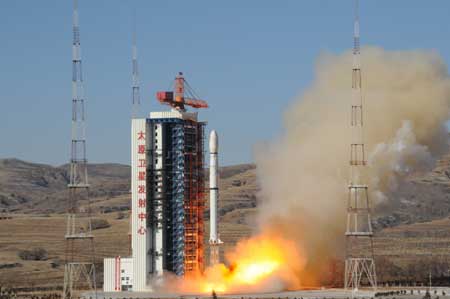 According
to China, Yaogan V is “used for data collection and transmission involving
land resources surveys, environmental surveillance and protection, urban
planning, crop yield estimates, disaster prevention and reduction and space
science experiments.” The satellite was developed by the China Aerospace
Science and Technology Corp., Yaogan IV was launched
only two weeks earlier as Yaogan III" was launched in November 2007. According
to China, Yaogan V is “used for data collection and transmission involving
land resources surveys, environmental surveillance and protection, urban
planning, crop yield estimates, disaster prevention and reduction and space
science experiments.” The satellite was developed by the China Aerospace
Science and Technology Corp., Yaogan IV was launched
only two weeks earlier as Yaogan III" was launched in November 2007. |
| Source: |
Jonathan
Space Report No. ; Spacewarn
No. ; National Space Science
Data Center's 2007-0 ; China Daily's 15
Dec 08 ; SkyRocket's
; |
|
|
.
Hot Bird 9
| Spacecraft: |
|
| Chronologies: |
2008 payload #106 ; 2008-065A ; 6,720th spacecraft. |
| Type: |
Communications |
| Families: |
|
| Ranks: |
|
| Sponsor: |
Eutelsat |
|
|
|
.
W2M
| Spacecraft: |
|
| Chronologies: |
2008 payload #107 ; 2008-065B ; 6,721st spacecraft. |
| Type: |
Communications |
| Families: |
|
| Ranks: |
|
| Sponsor: |
Eutelsat |
|
|
|
.
FY-2E / Feng Yun 2E
| Spacecraft: |
|
| Chronologies: |
2008 payload #108 ; 2008-066A ; 6,722nd spacecraft. |
| Type: |
Meteorology |
| Families: |
|
| Ranks: |
|
| Sponsor: |
China |
|
|
|
.
Kosmos 2447
| Spacecraft: |
Glonass-M |
| Chronologies: |
2008 payload #109 ; 2008-067A ; 6,723rd spacecraft. |
| Type: |
Navigation |
| Families: |
|
| Ranks: |
|
| Sponsor: |
Russian Dedfense Ministry |
|
|
|
.
Kosmos 2448
| Spacecraft: |
Glonass-M |
| Chronologies: |
2008 payload #110 ; 2008-067B ; 6,724th spacecraft. |
| Type: |
Navigation |
| Families: |
|
| Ranks: |
|
| Sponsor: |
Russian Dedfense Ministry |
|
|
|
.
Kosmos 2449
| Spacecraft: |
Glonass-M |
| Chronologies: |
2008 payload #111 ; 2008-067C ; 6,725th spacecraft. |
| Type: |
Navigation |
| Families: |
|
| Ranks: |
|
| Sponsor: |
Russian Dedfense Ministry |
|
|
|
|
